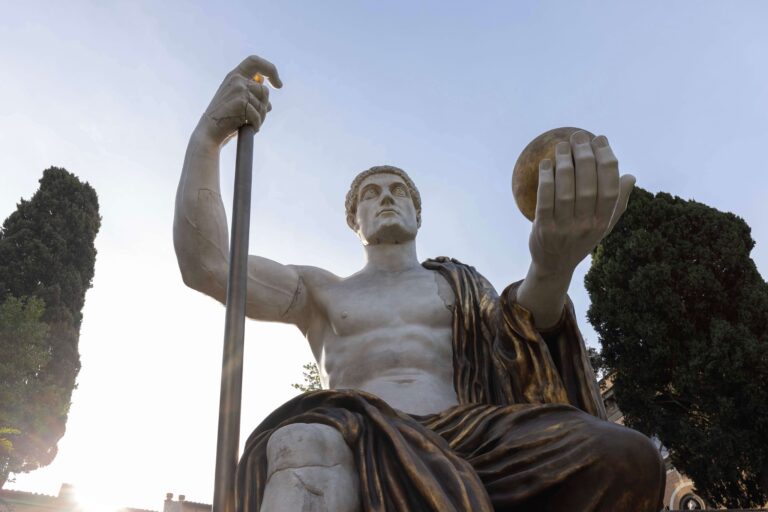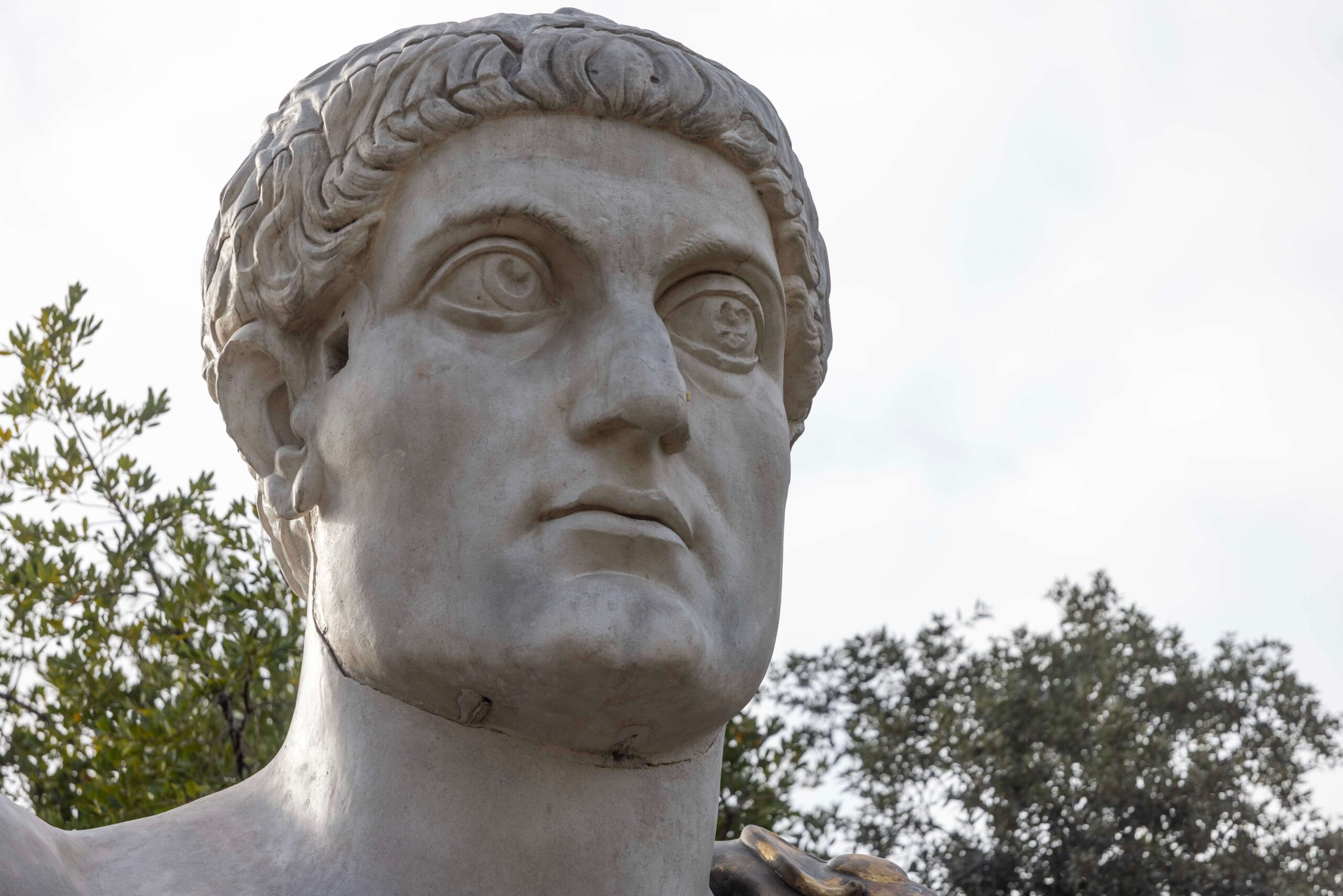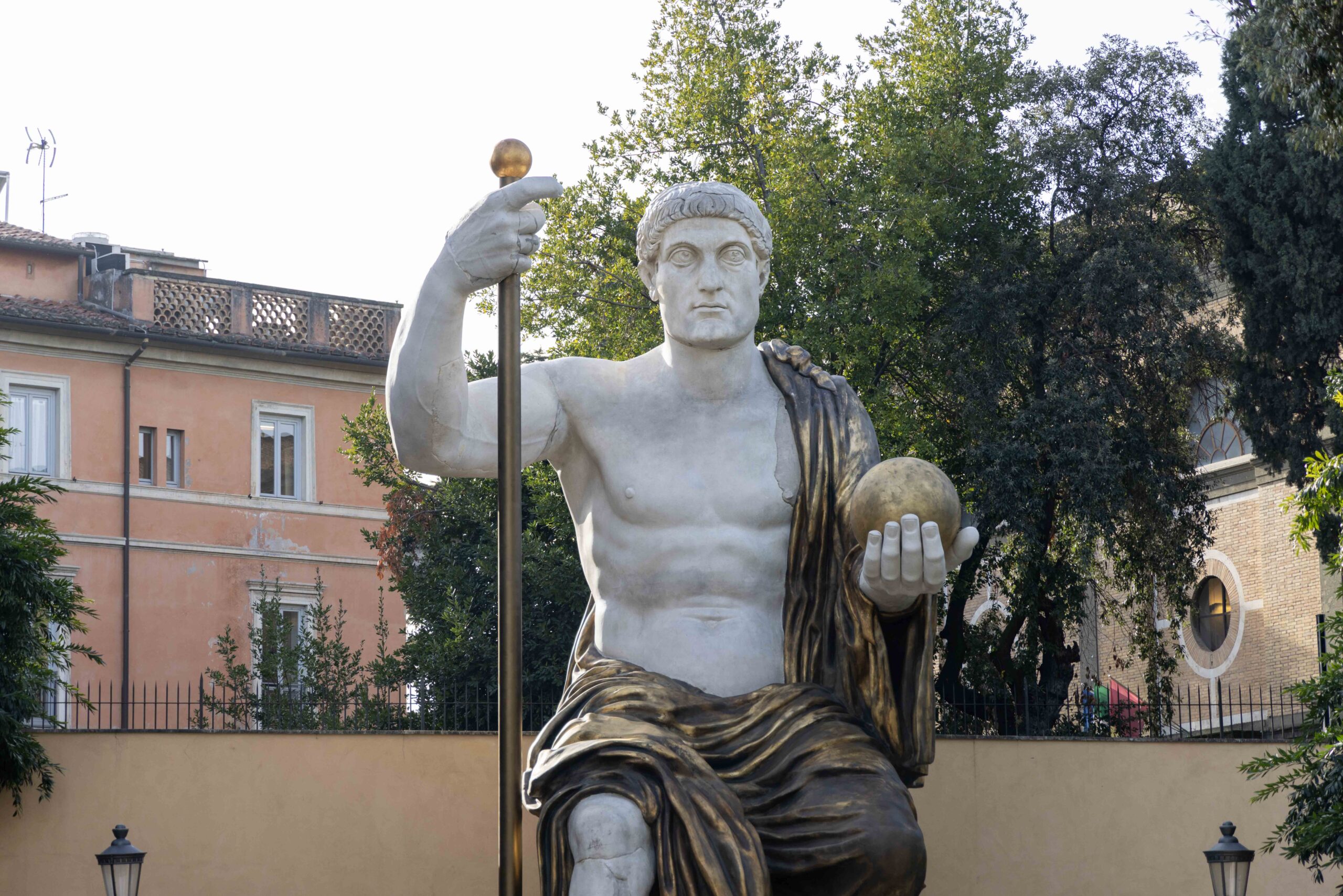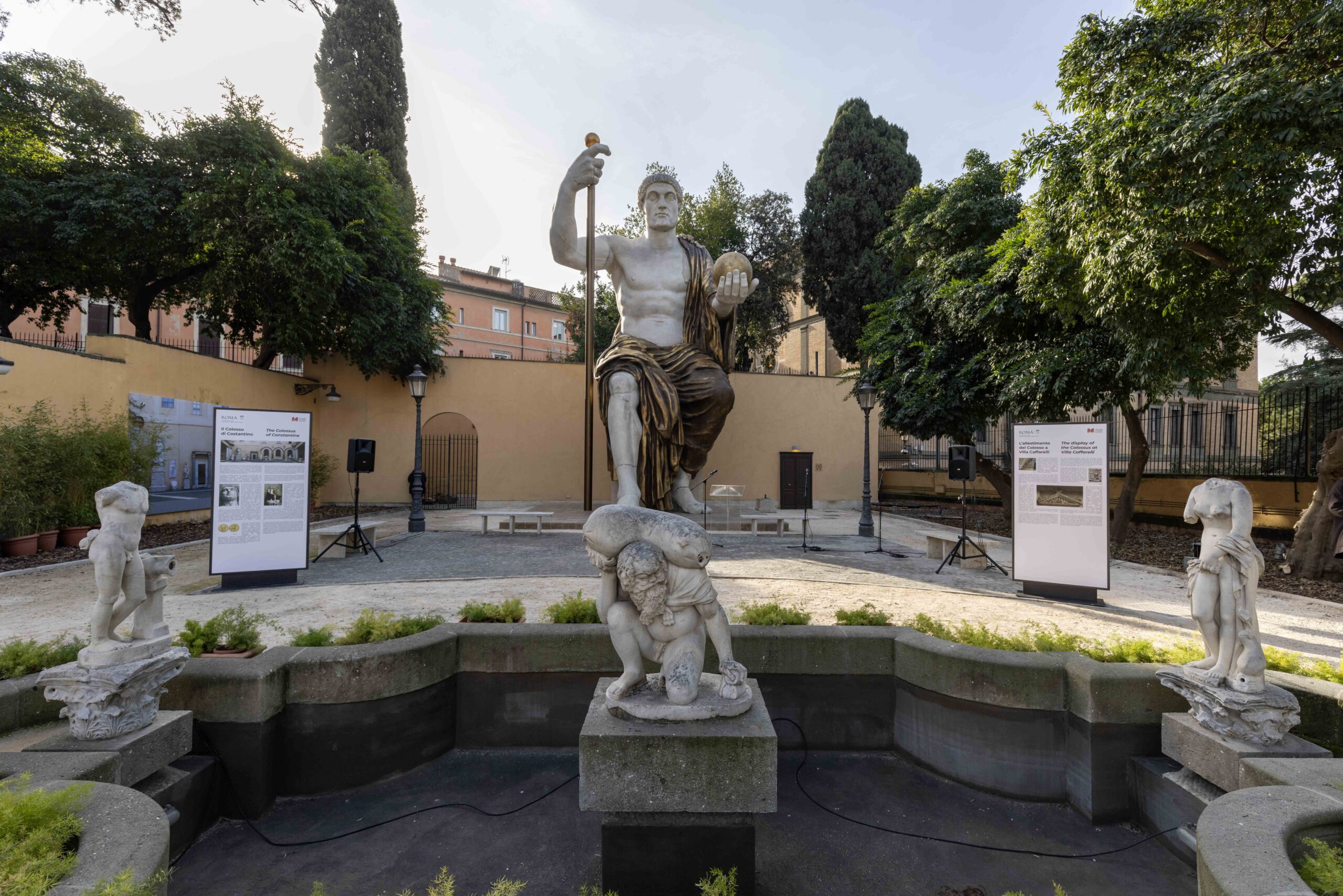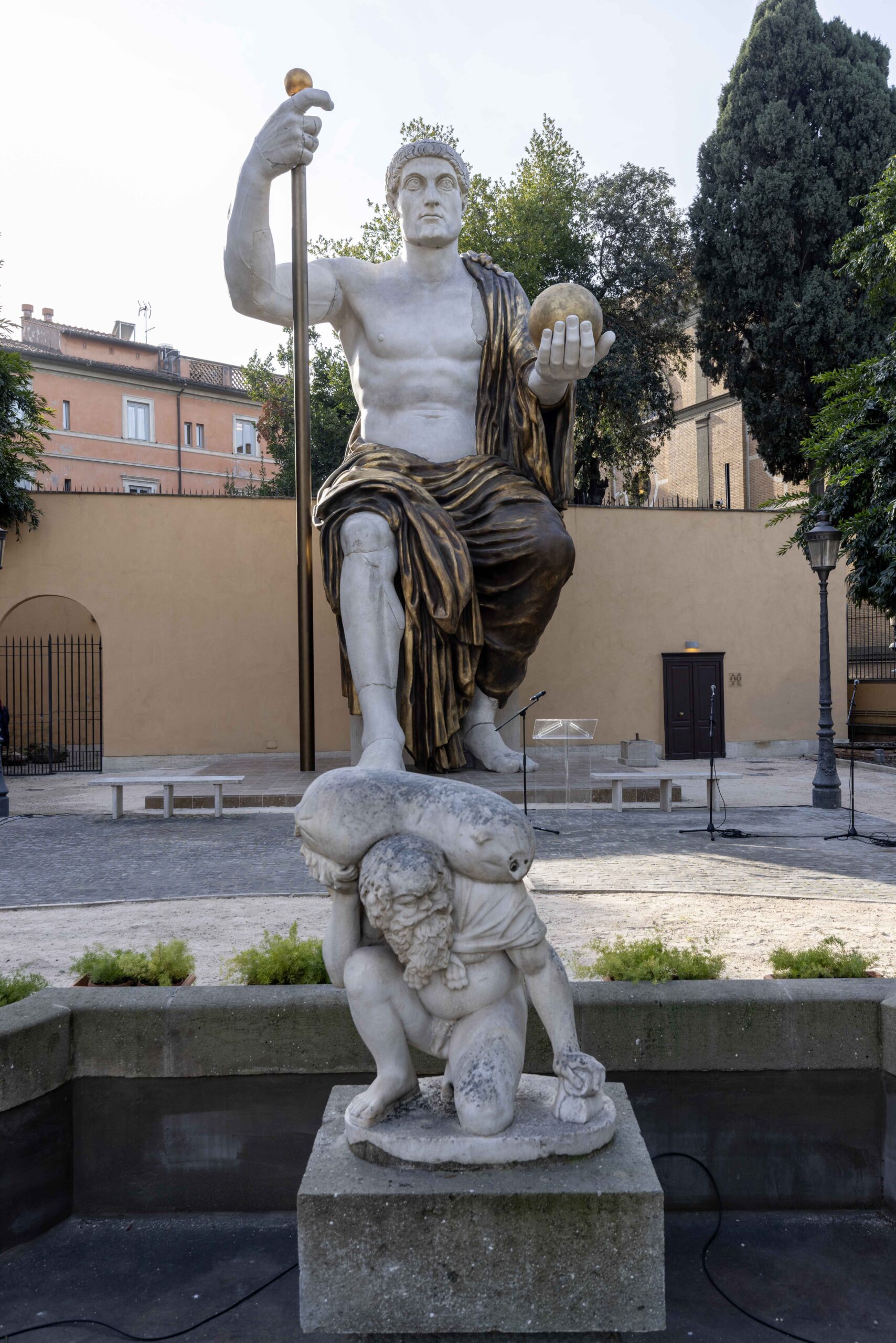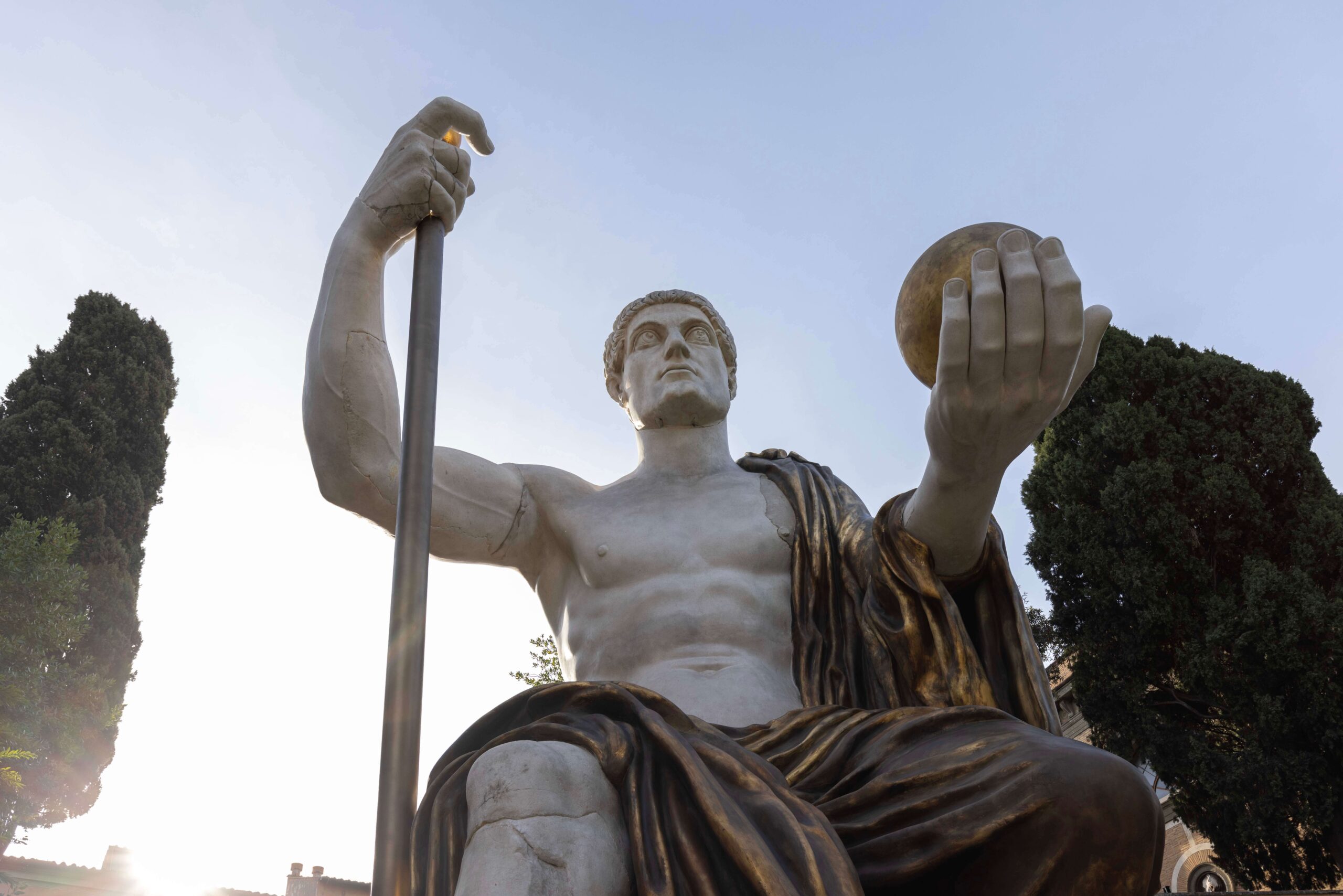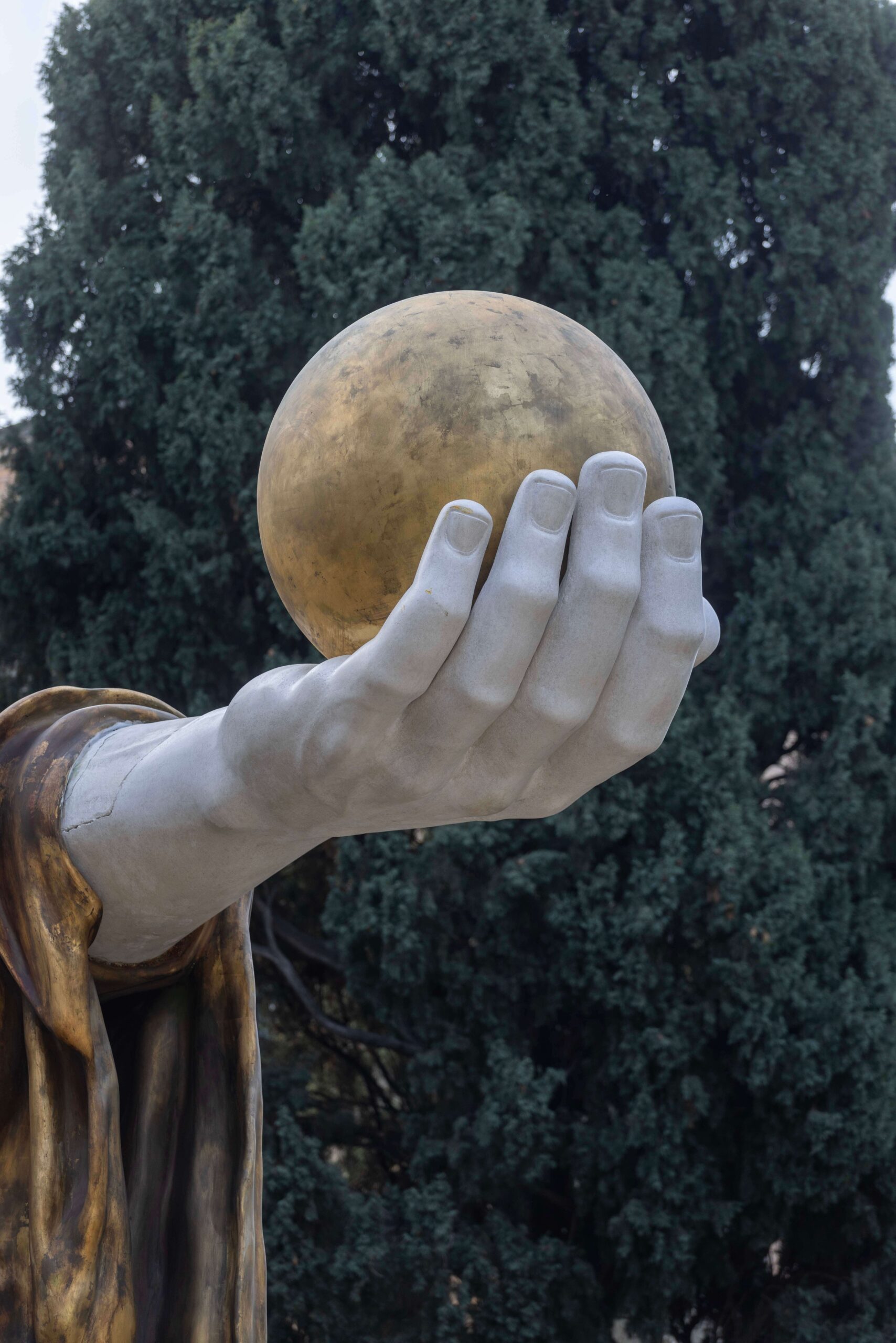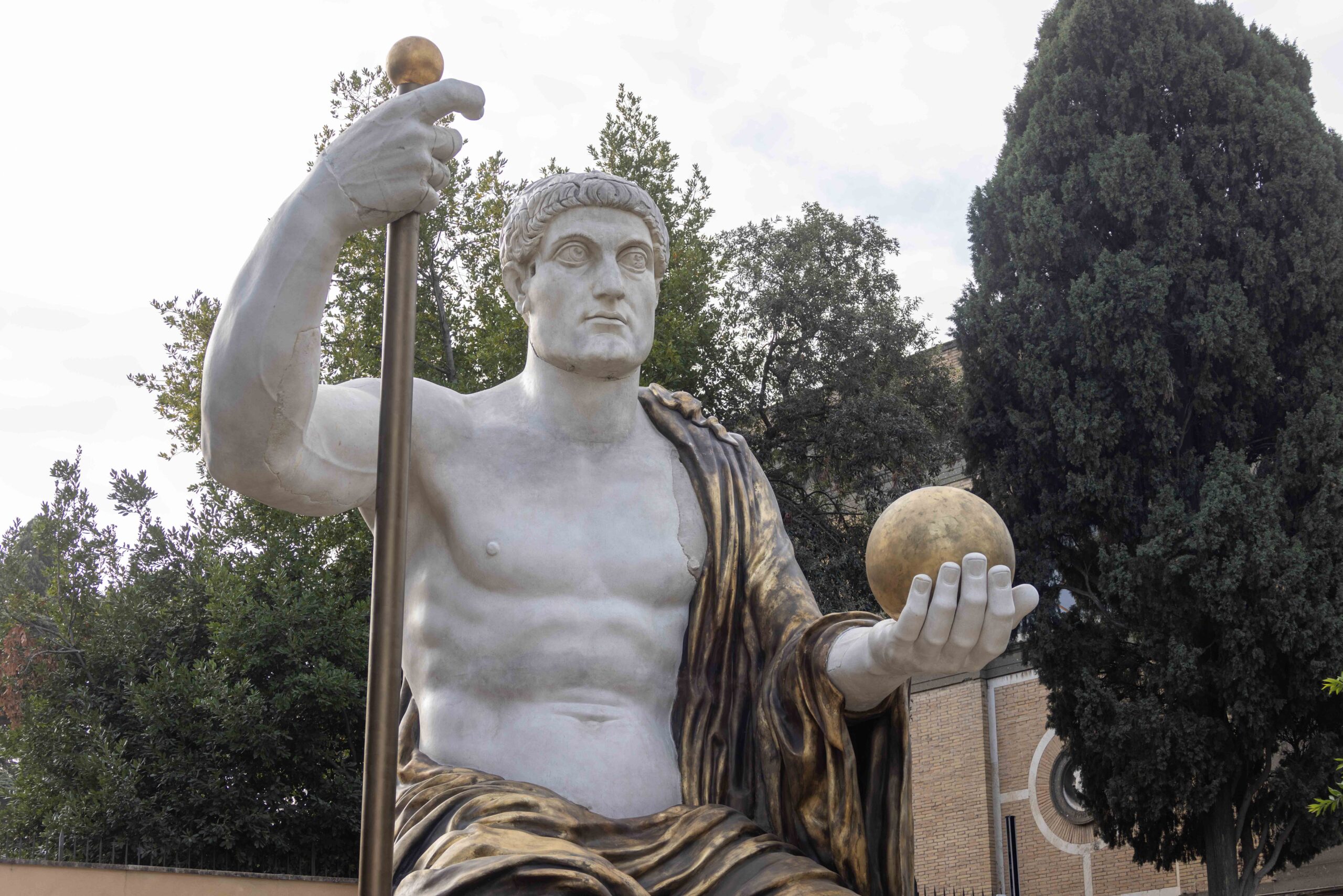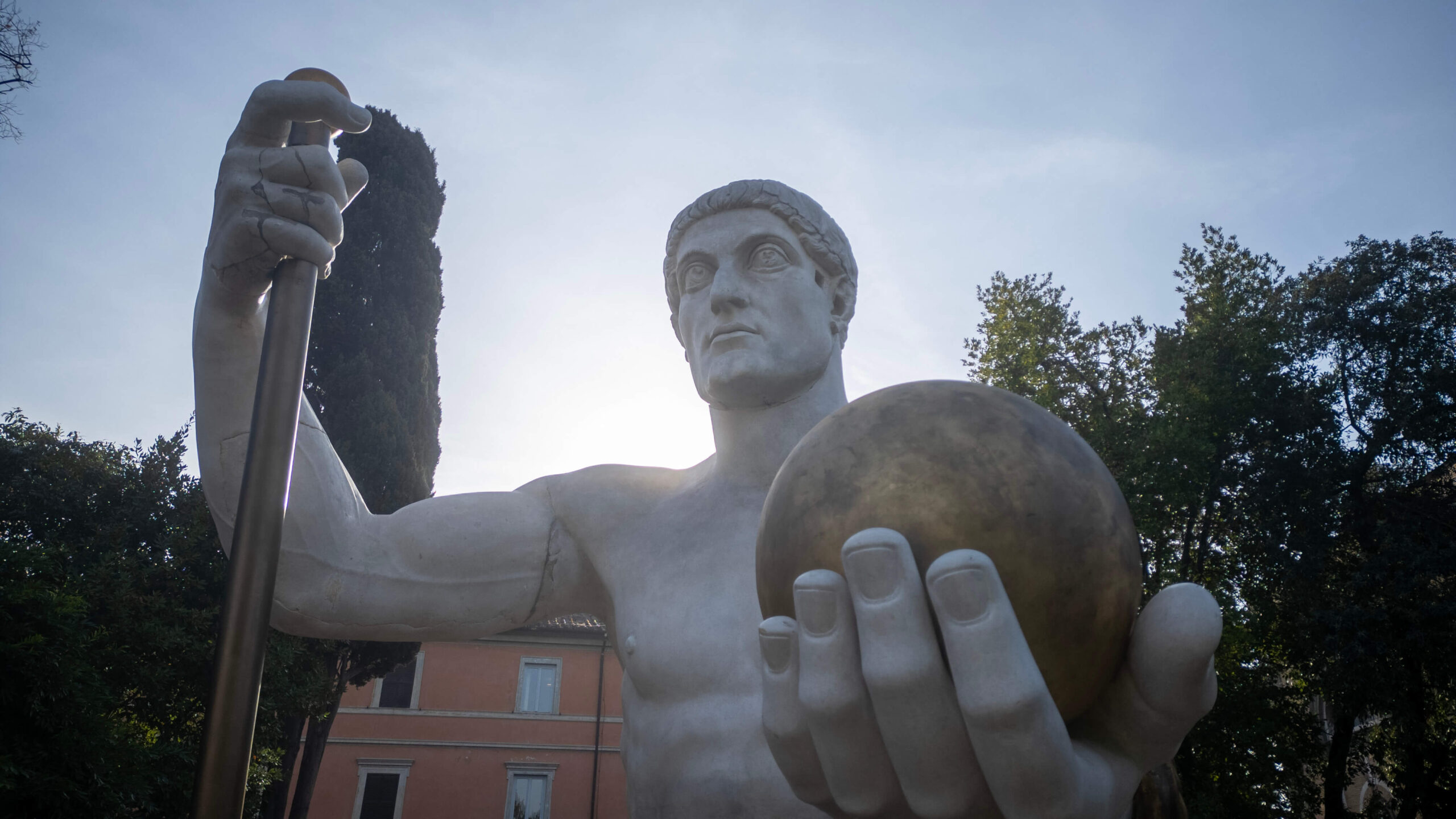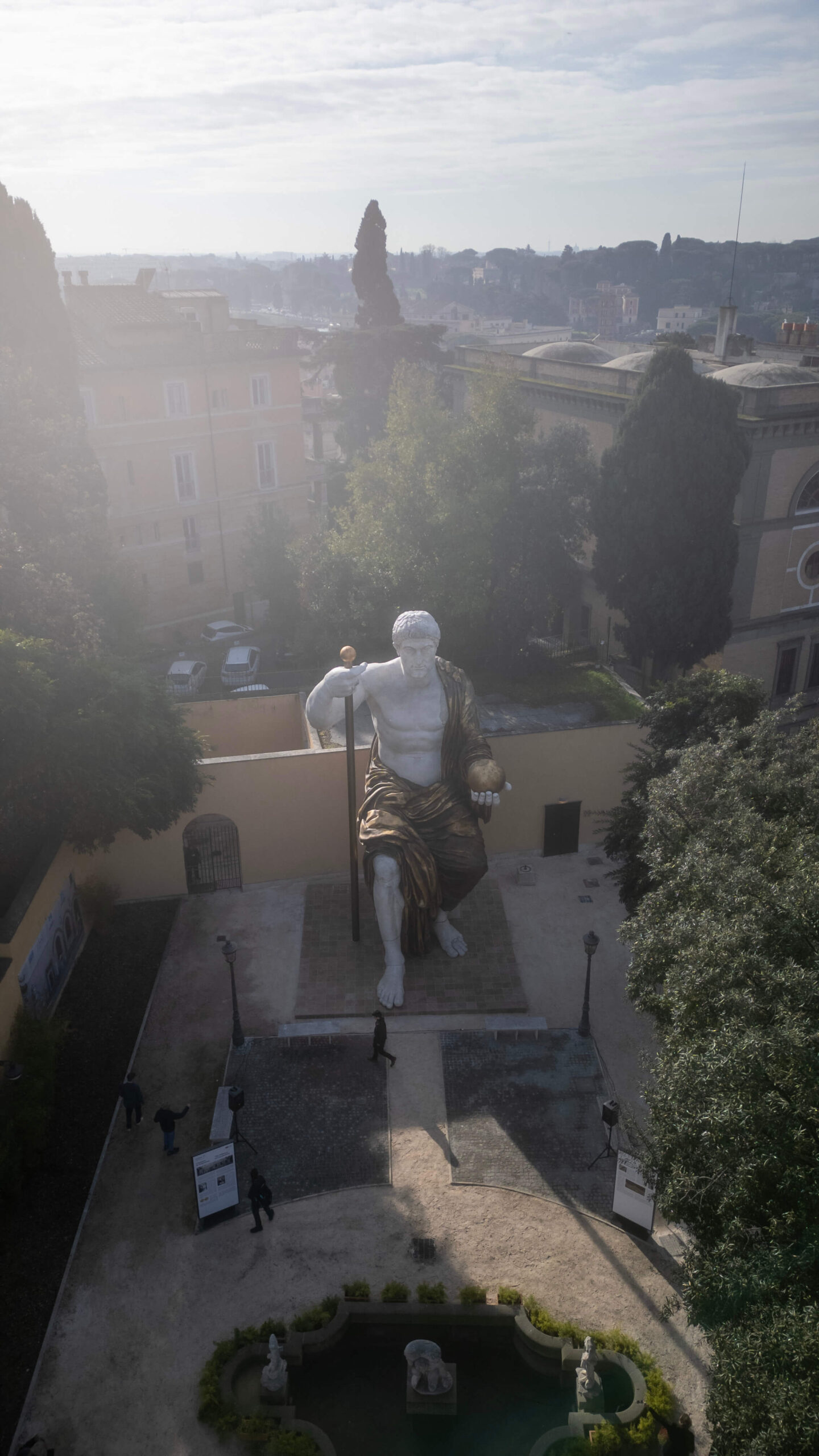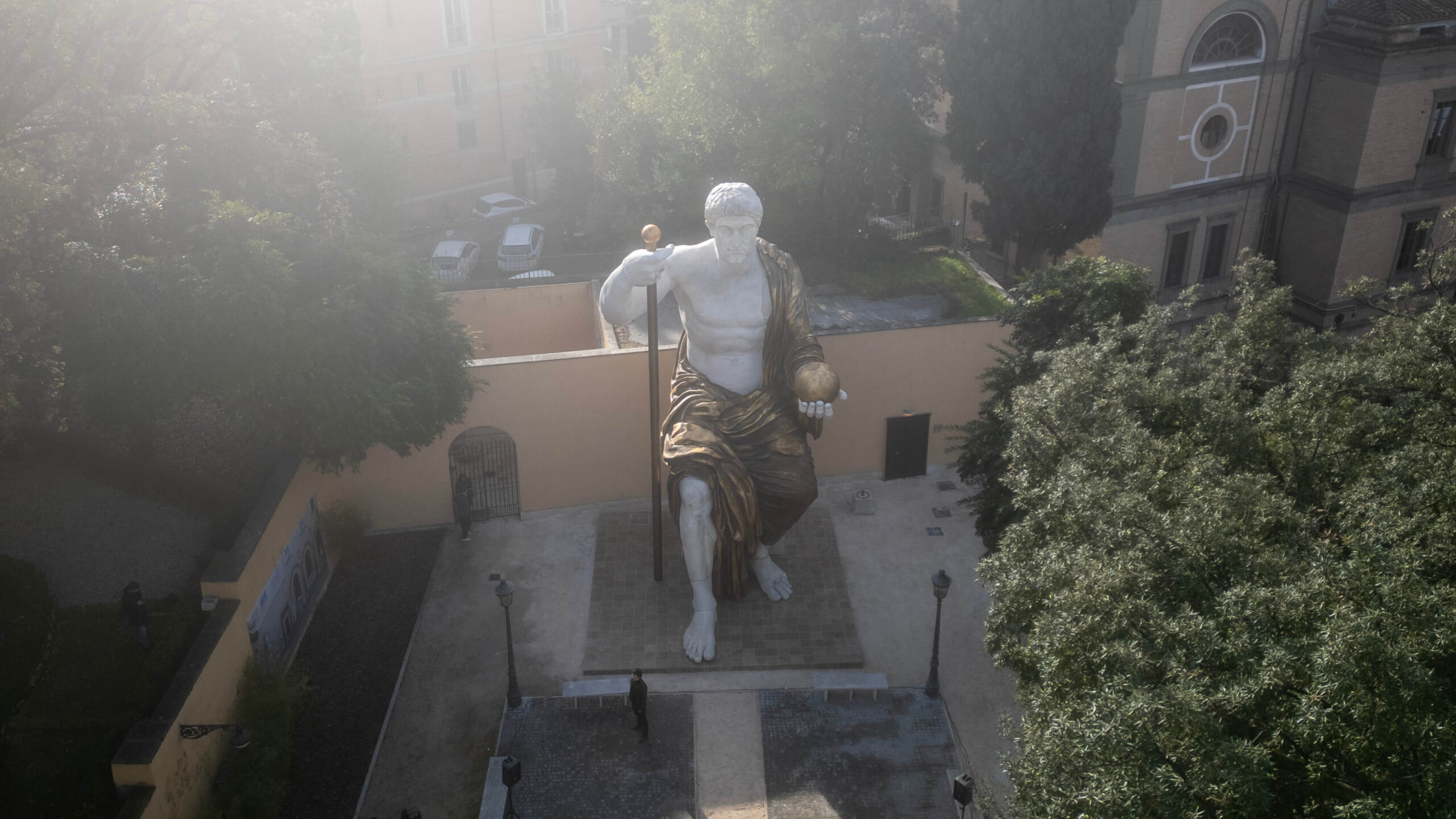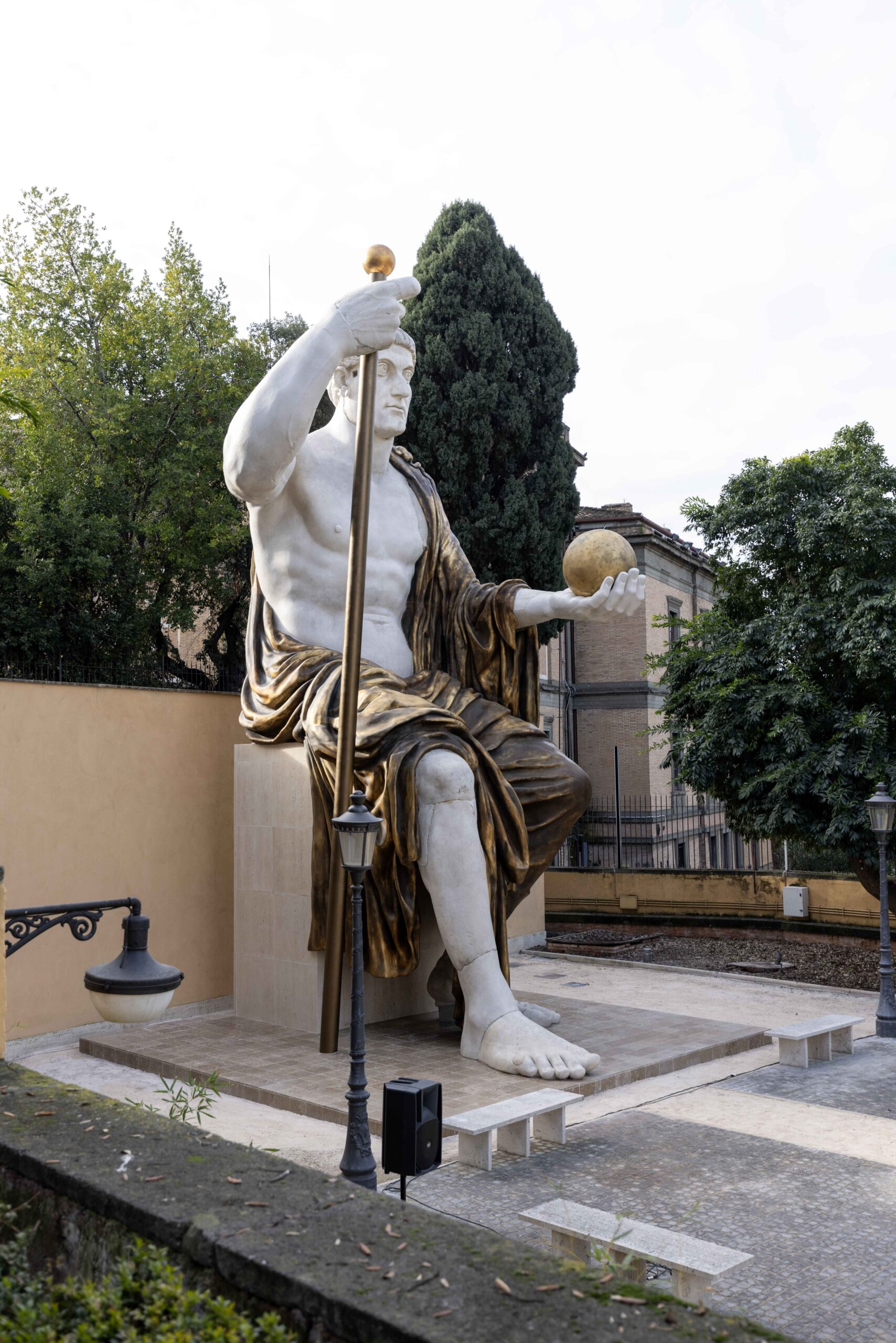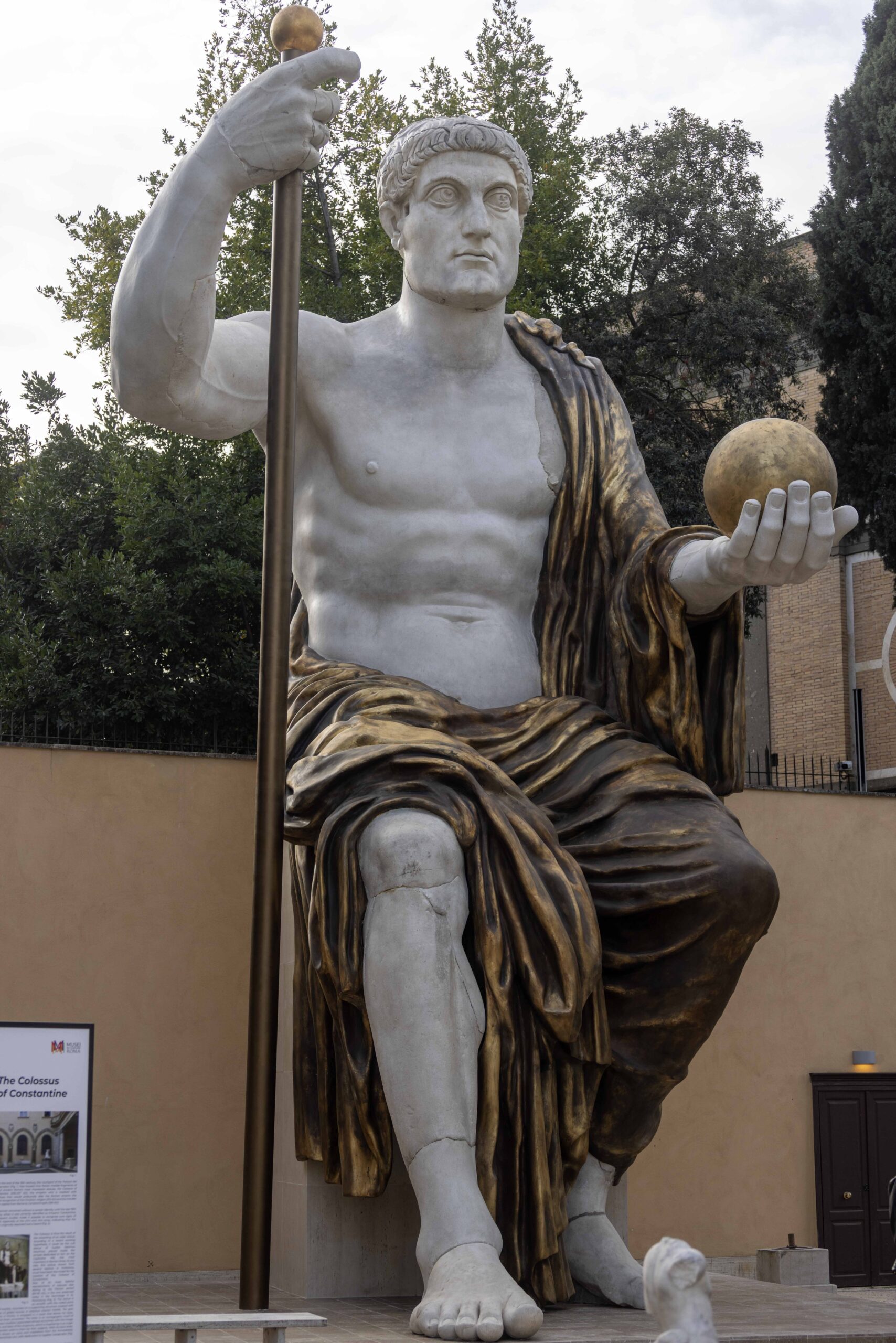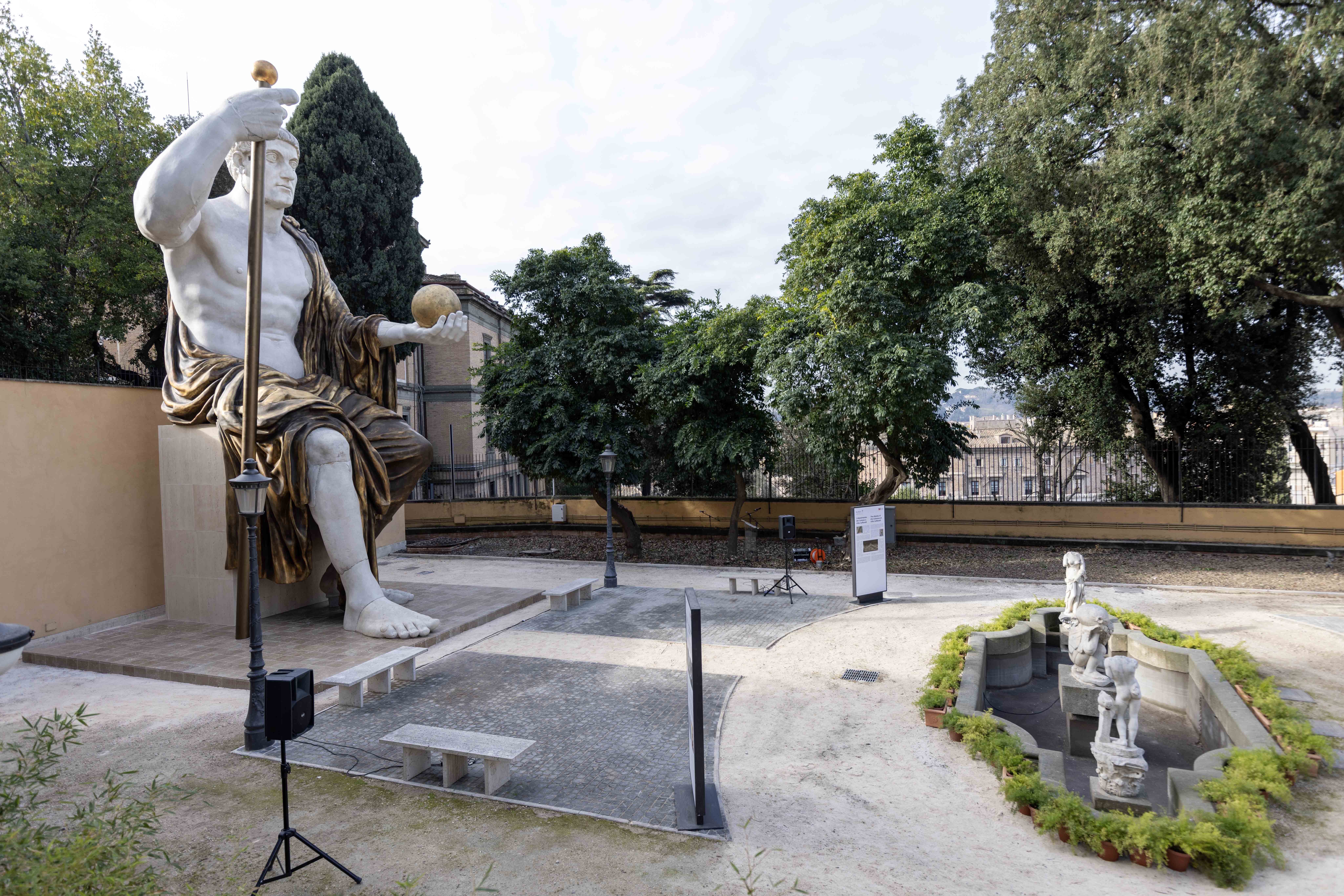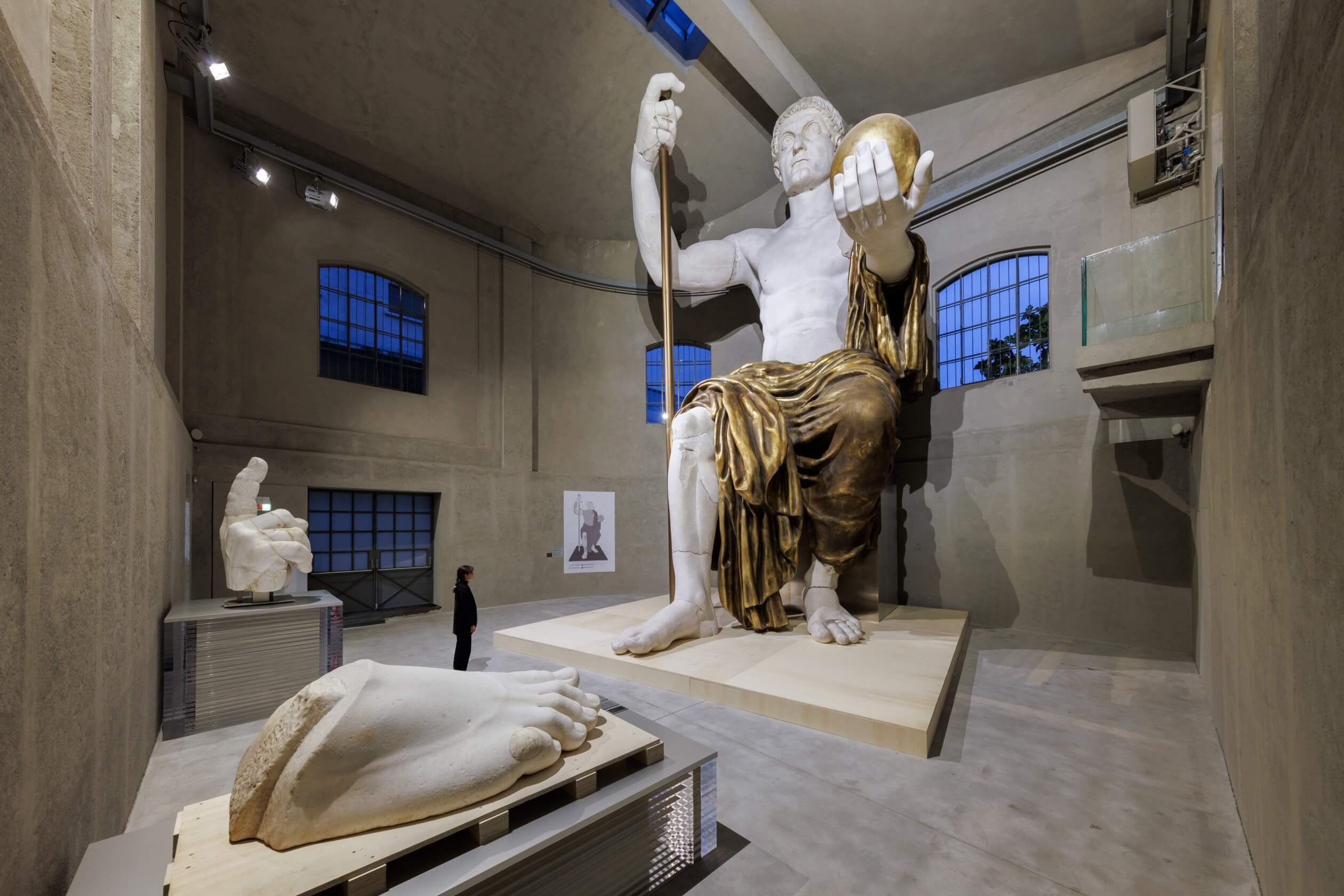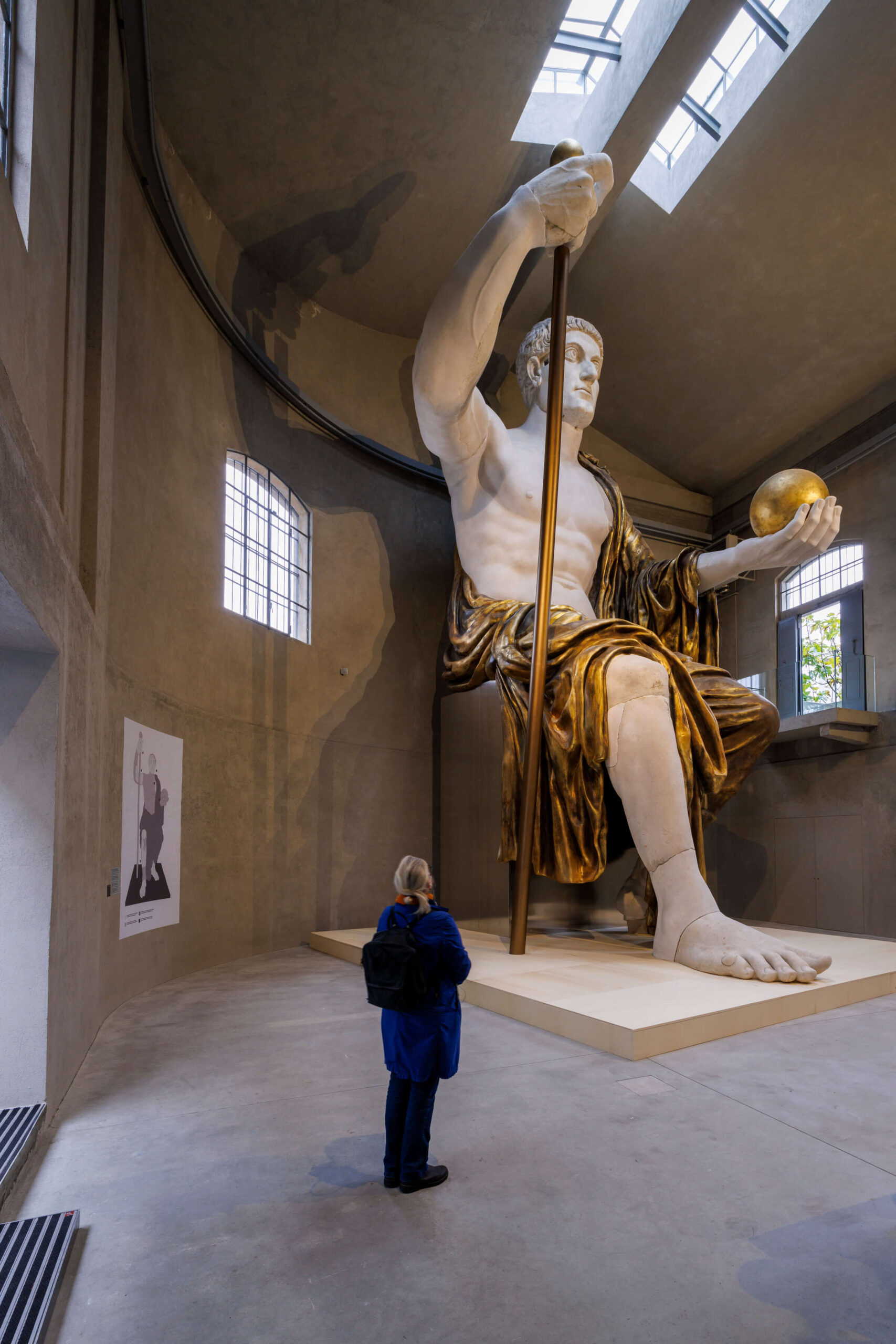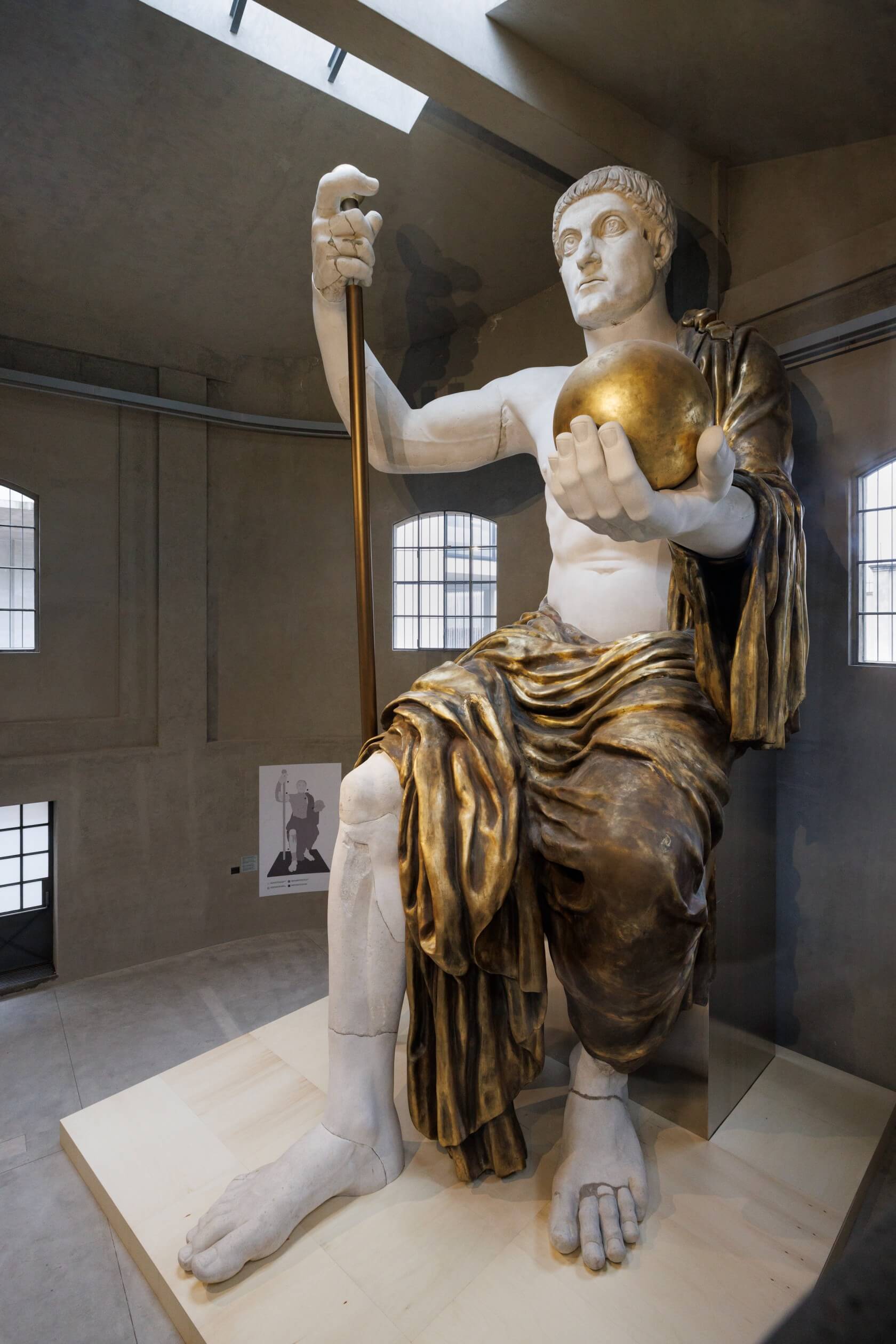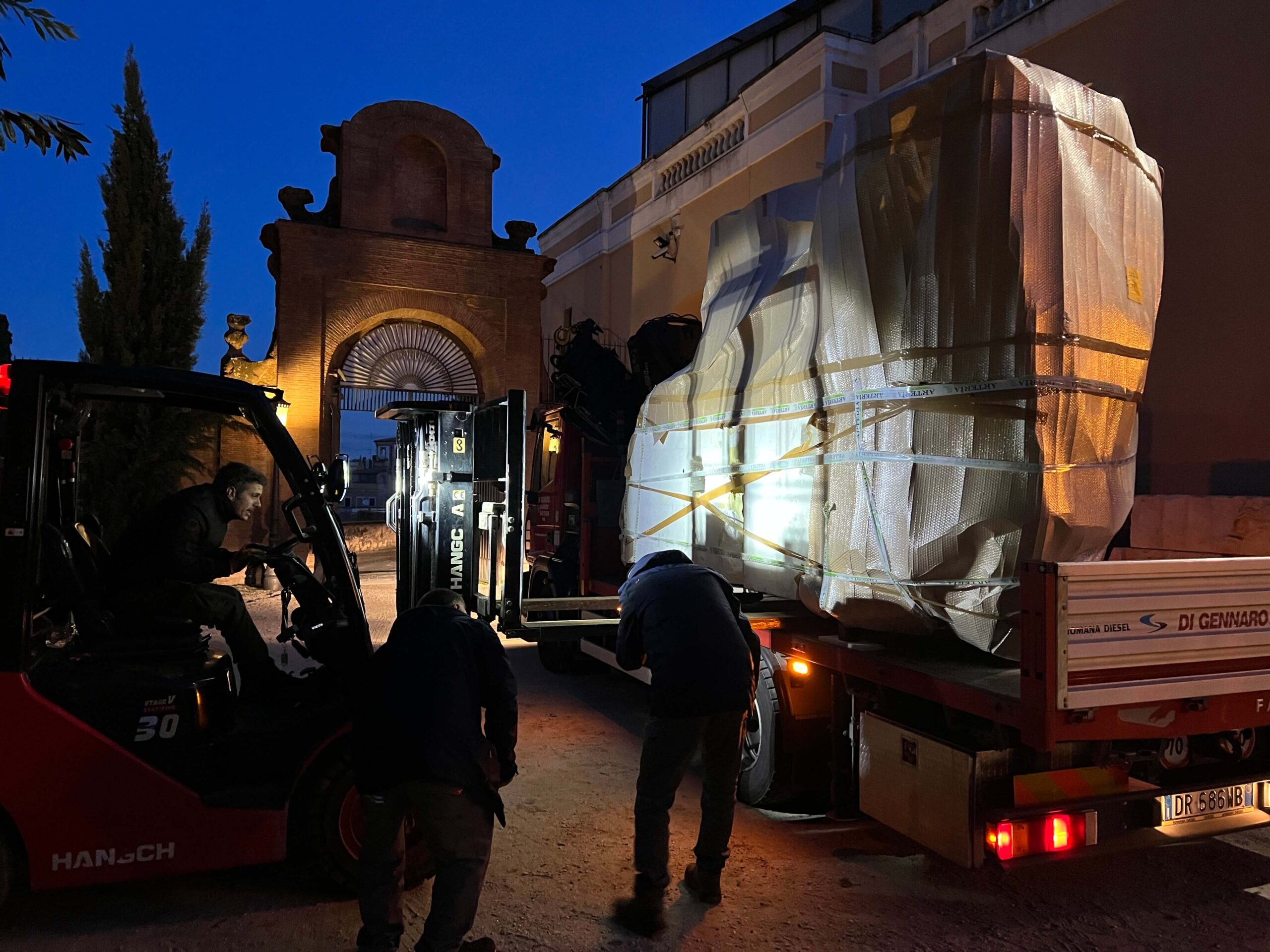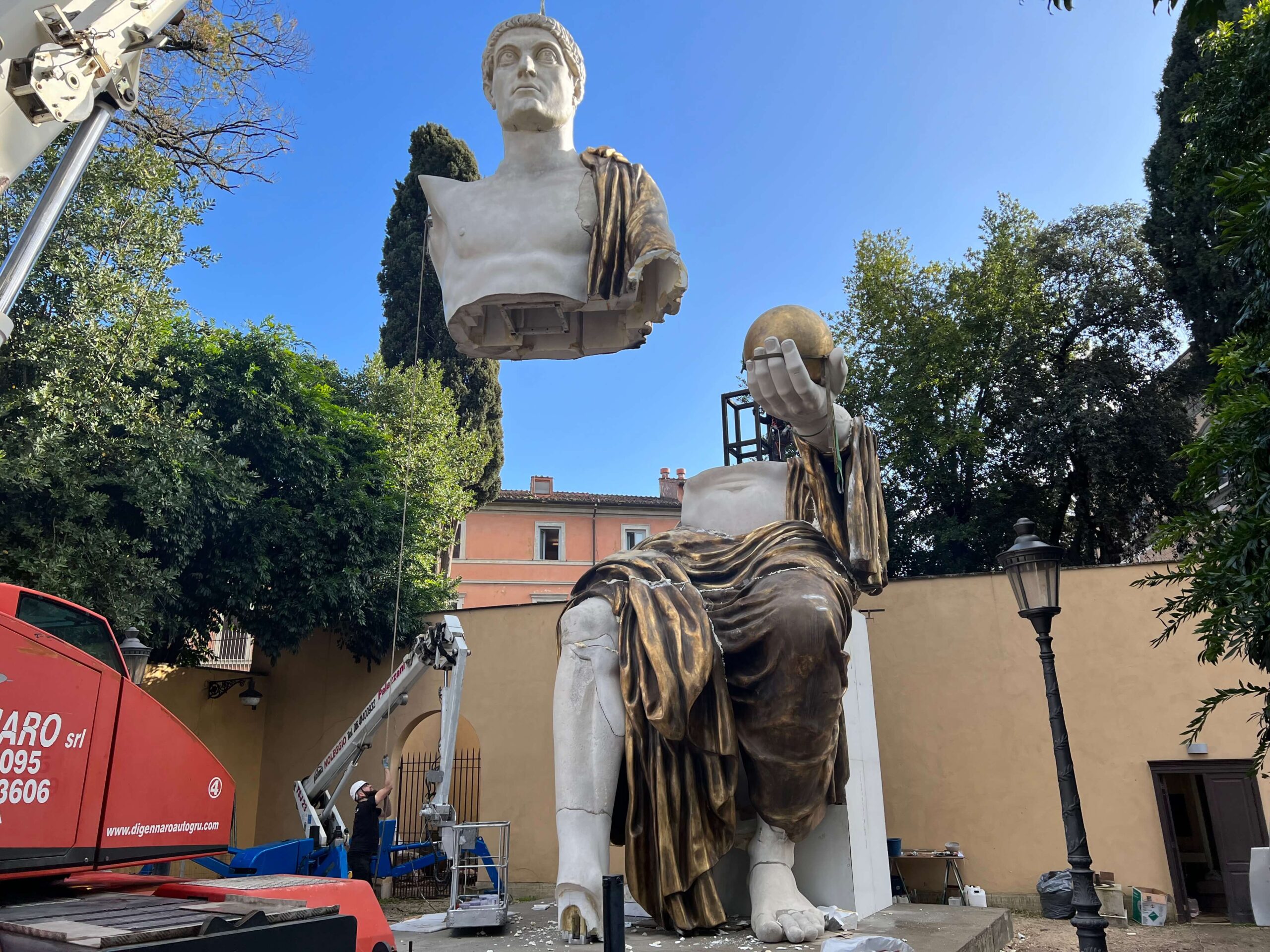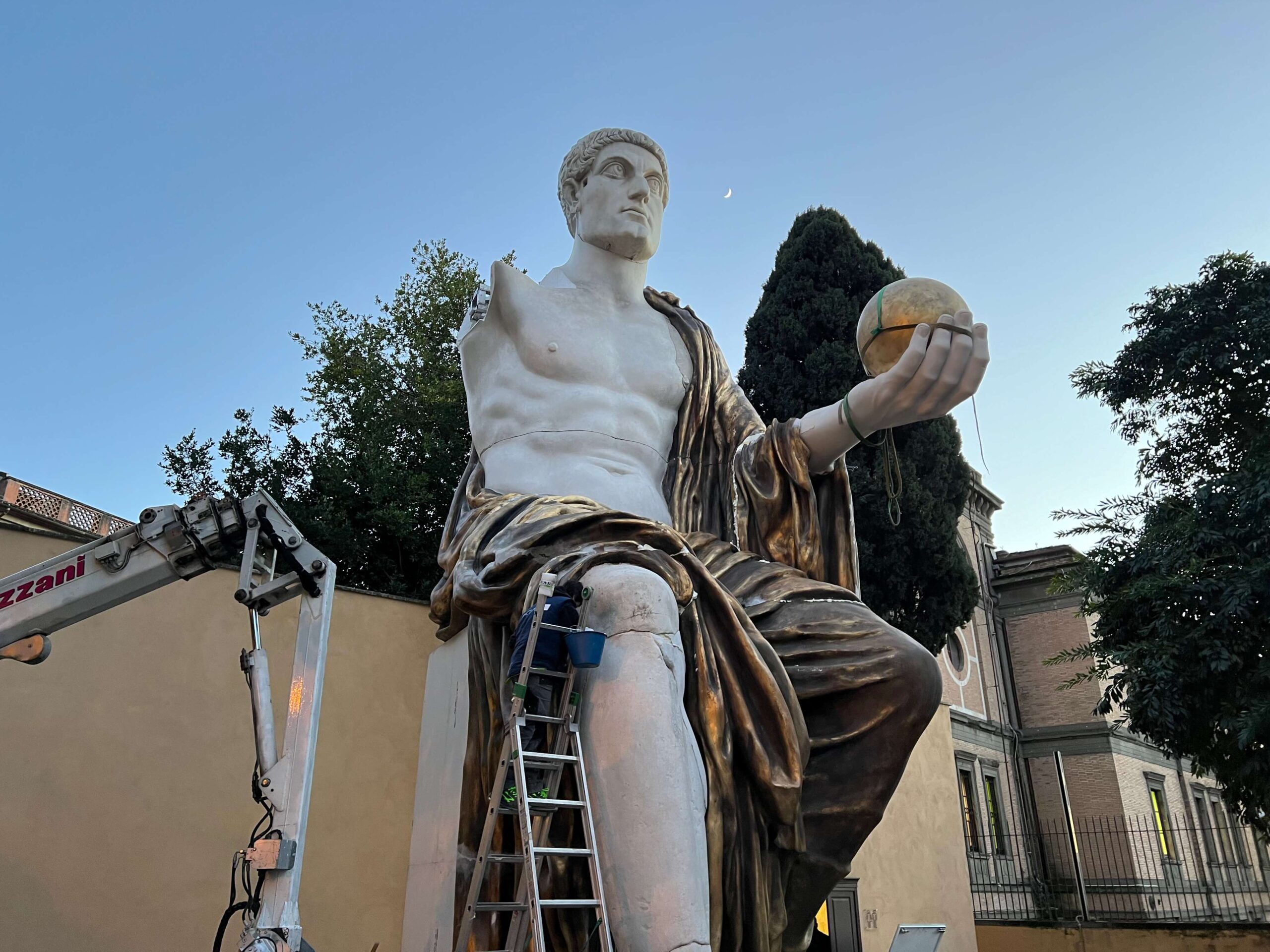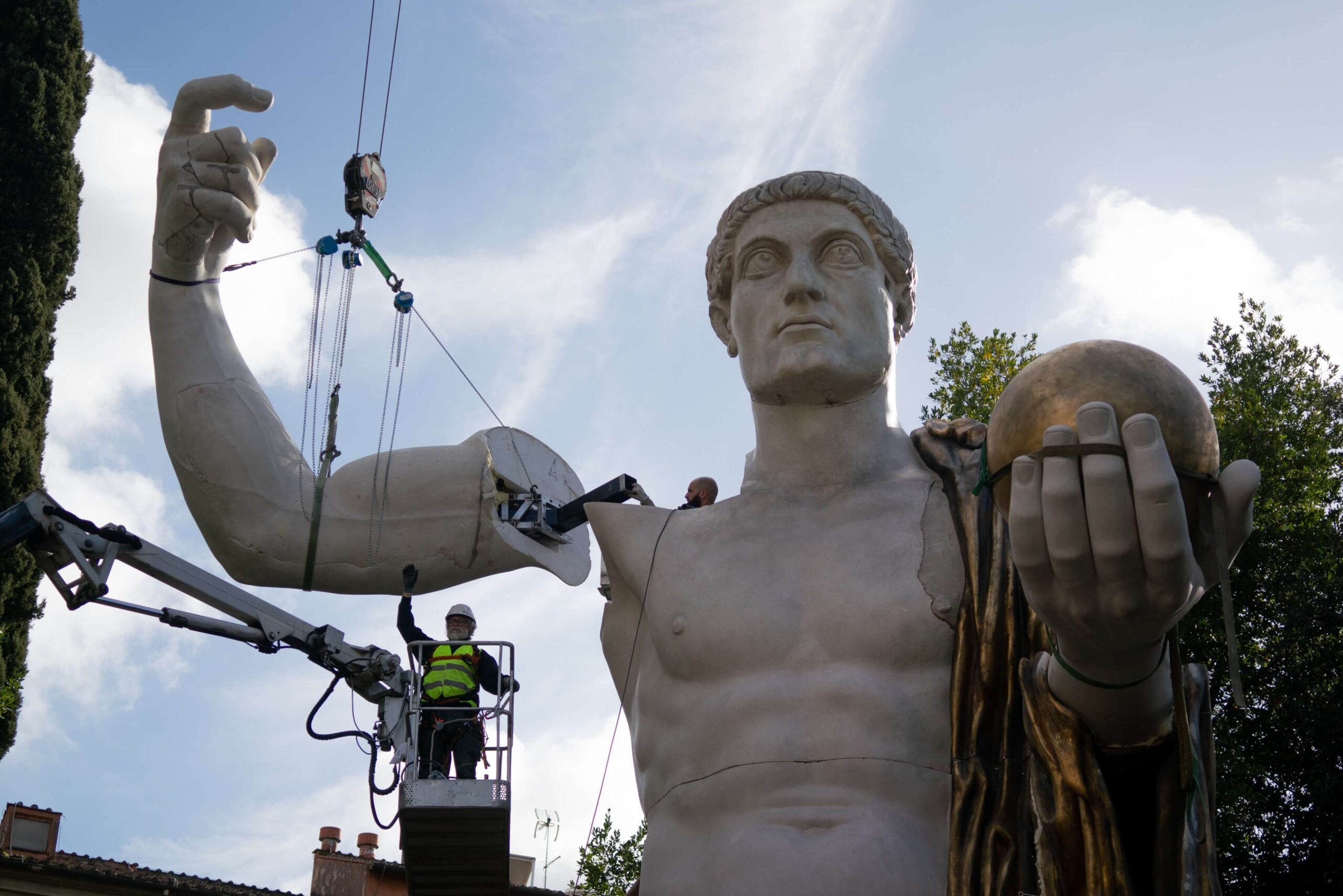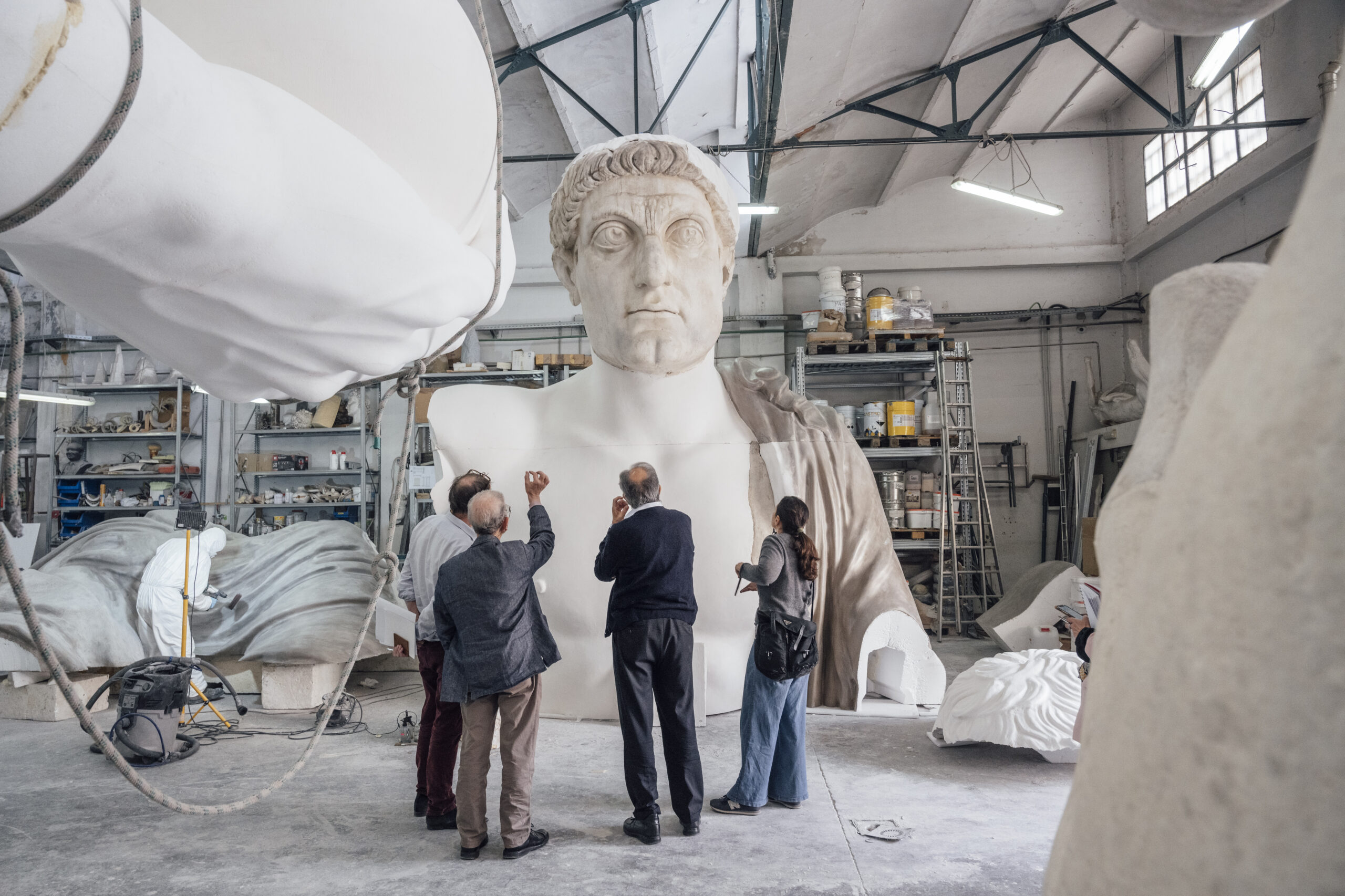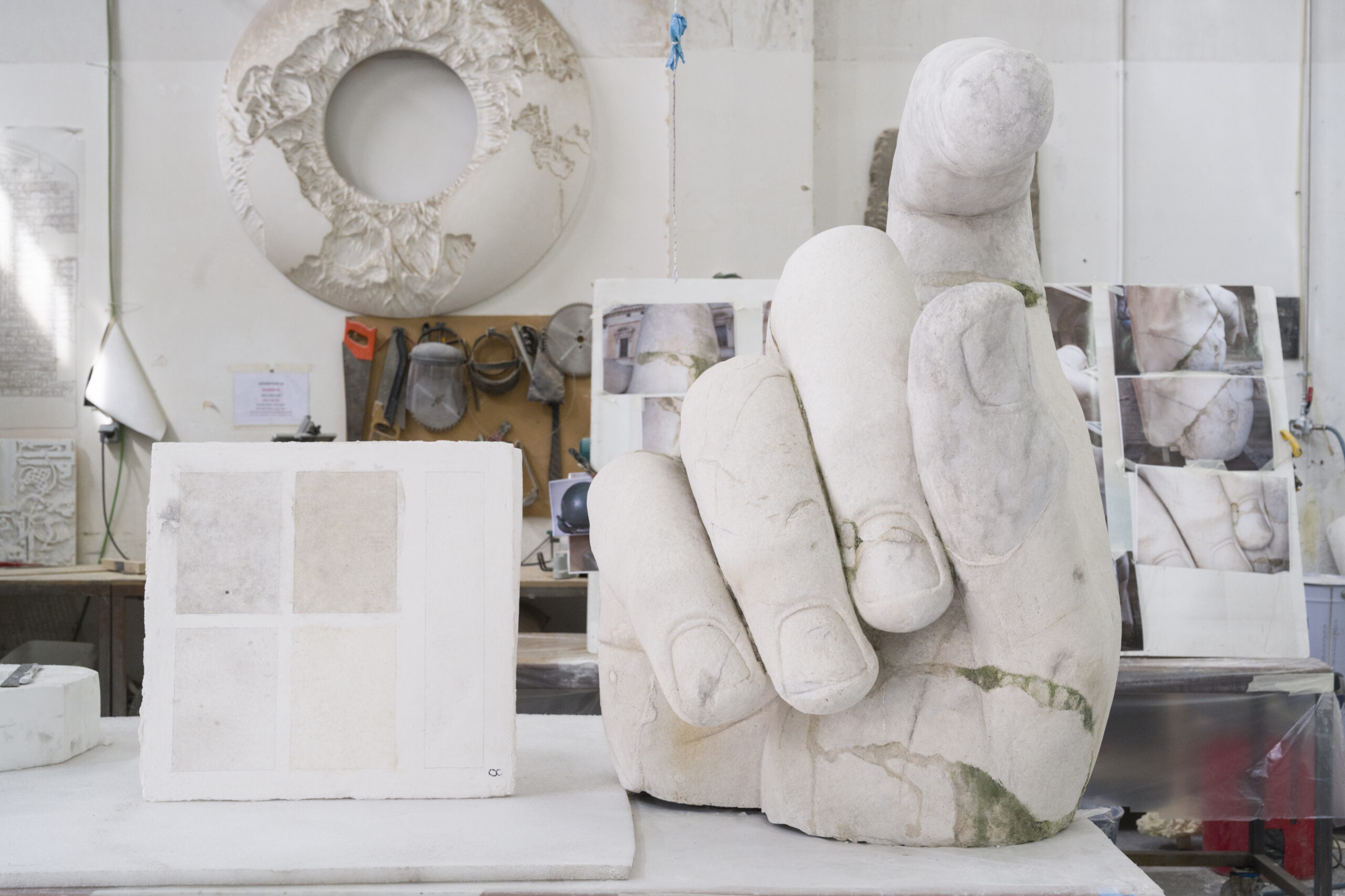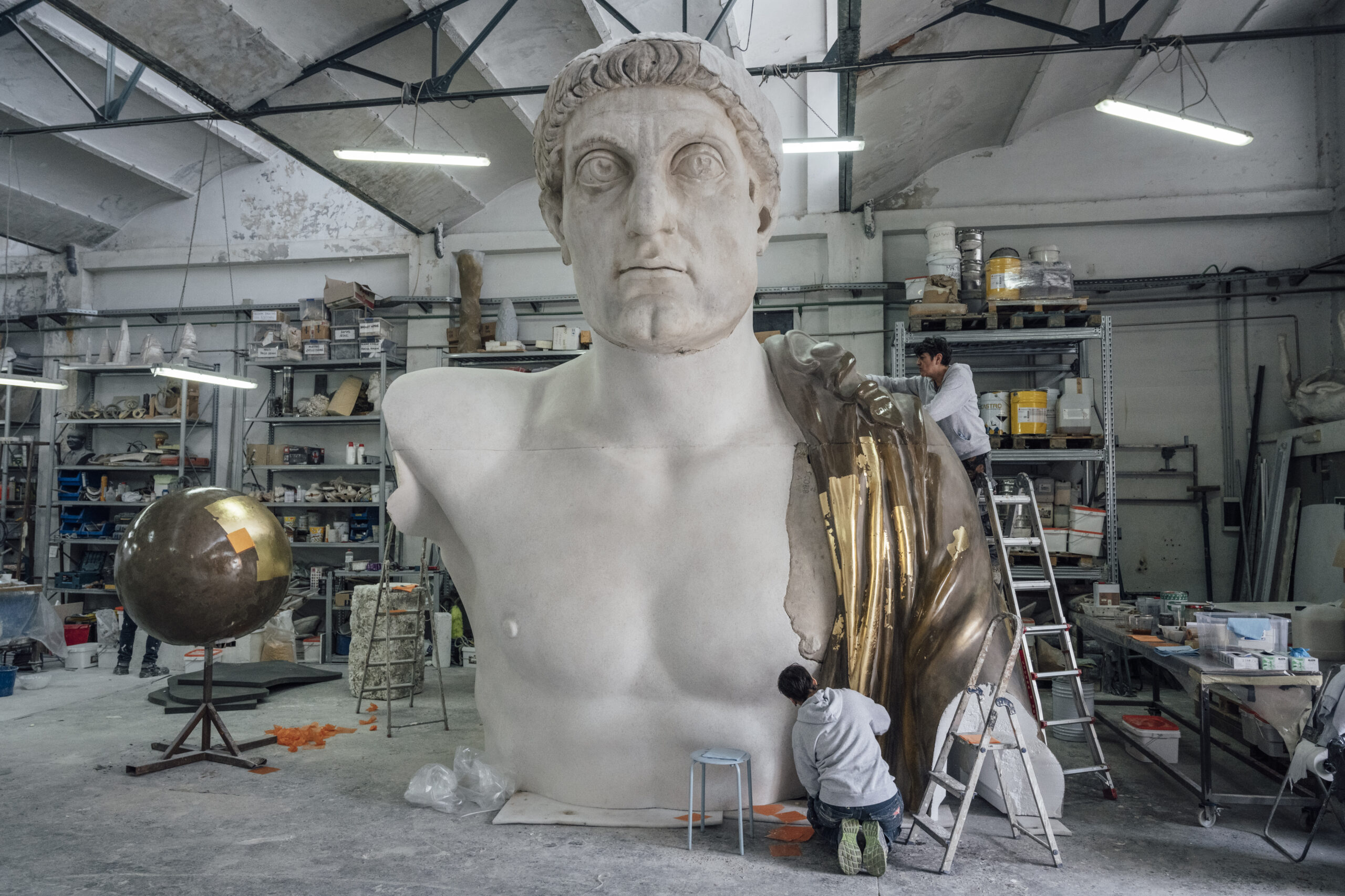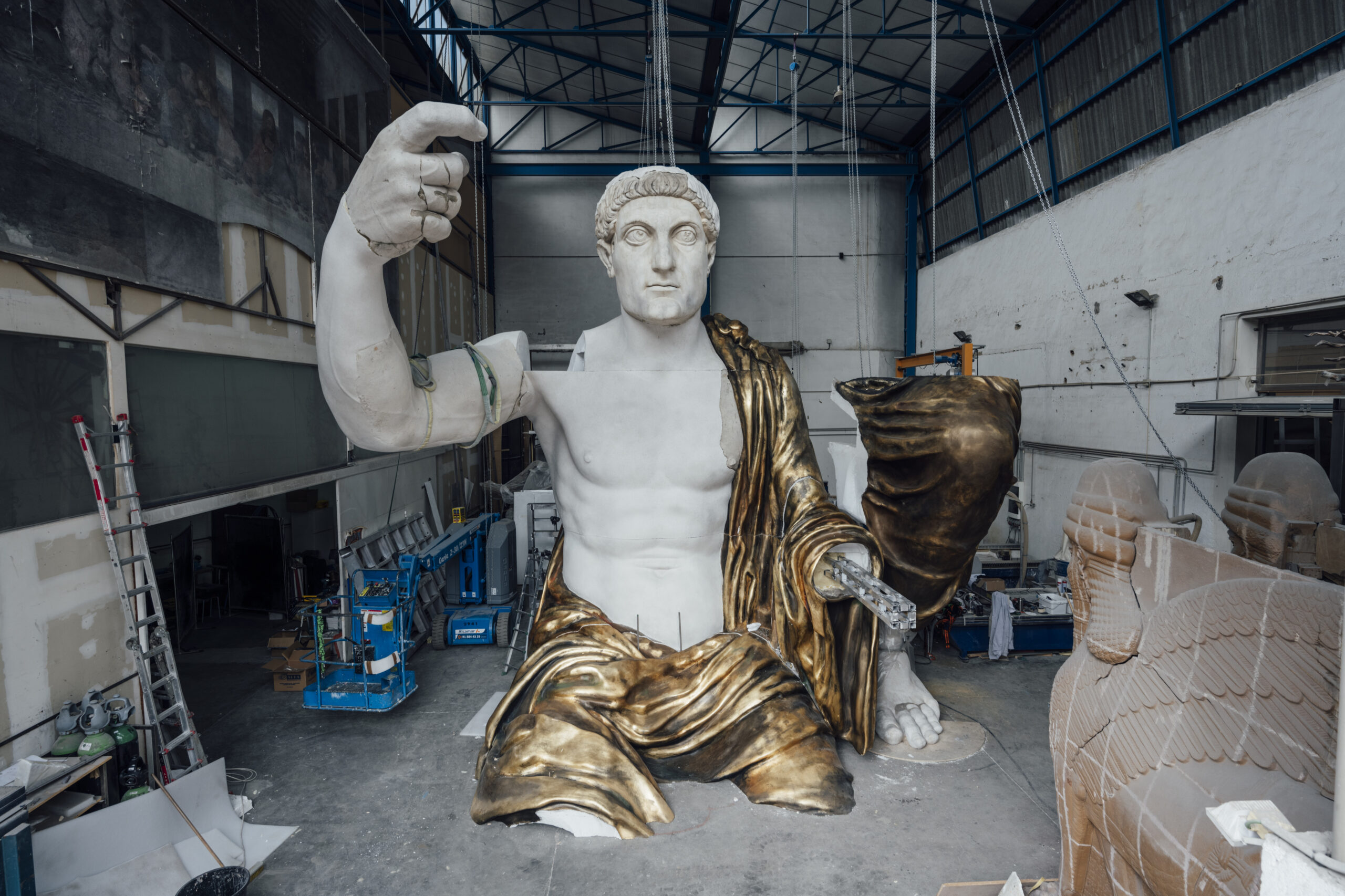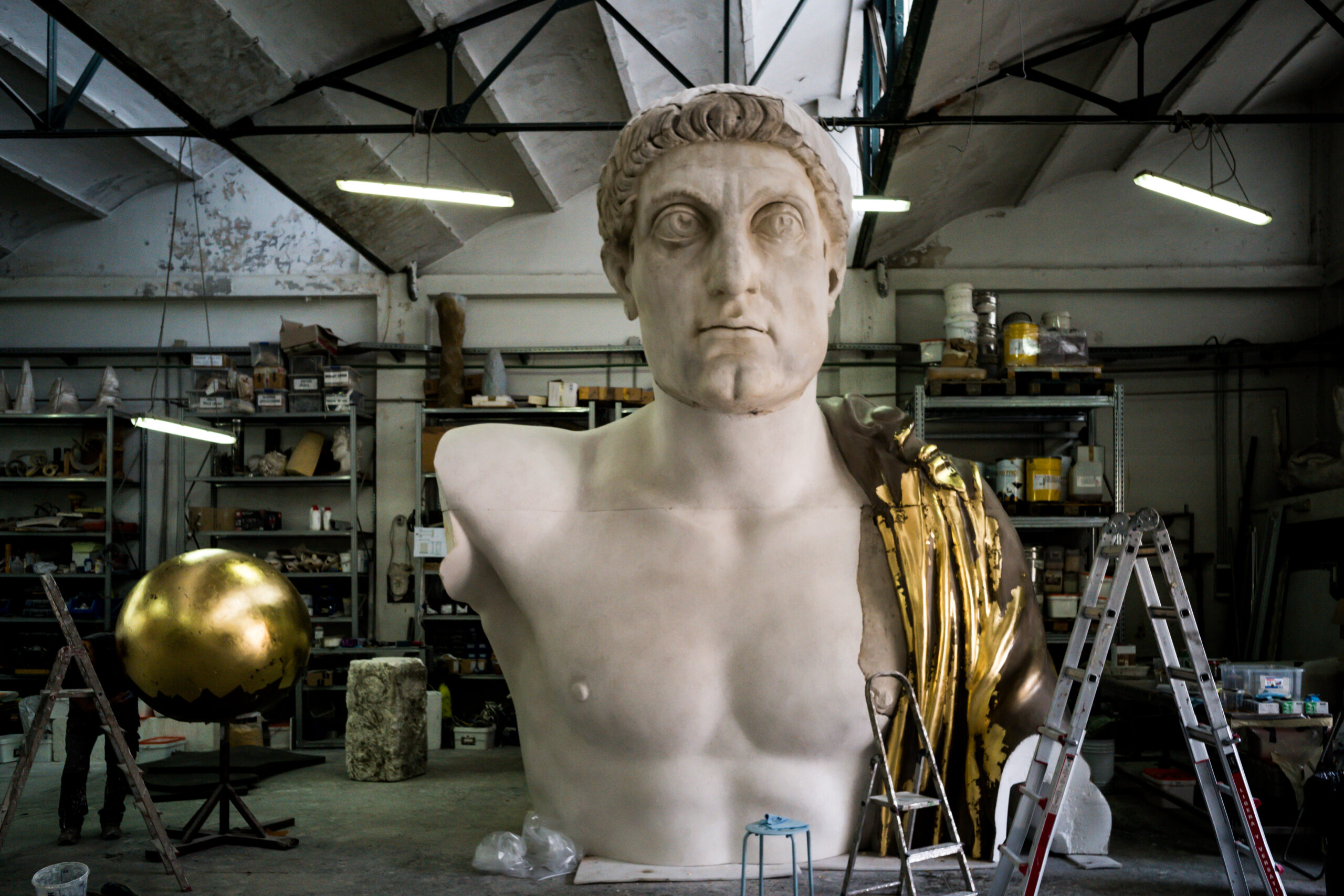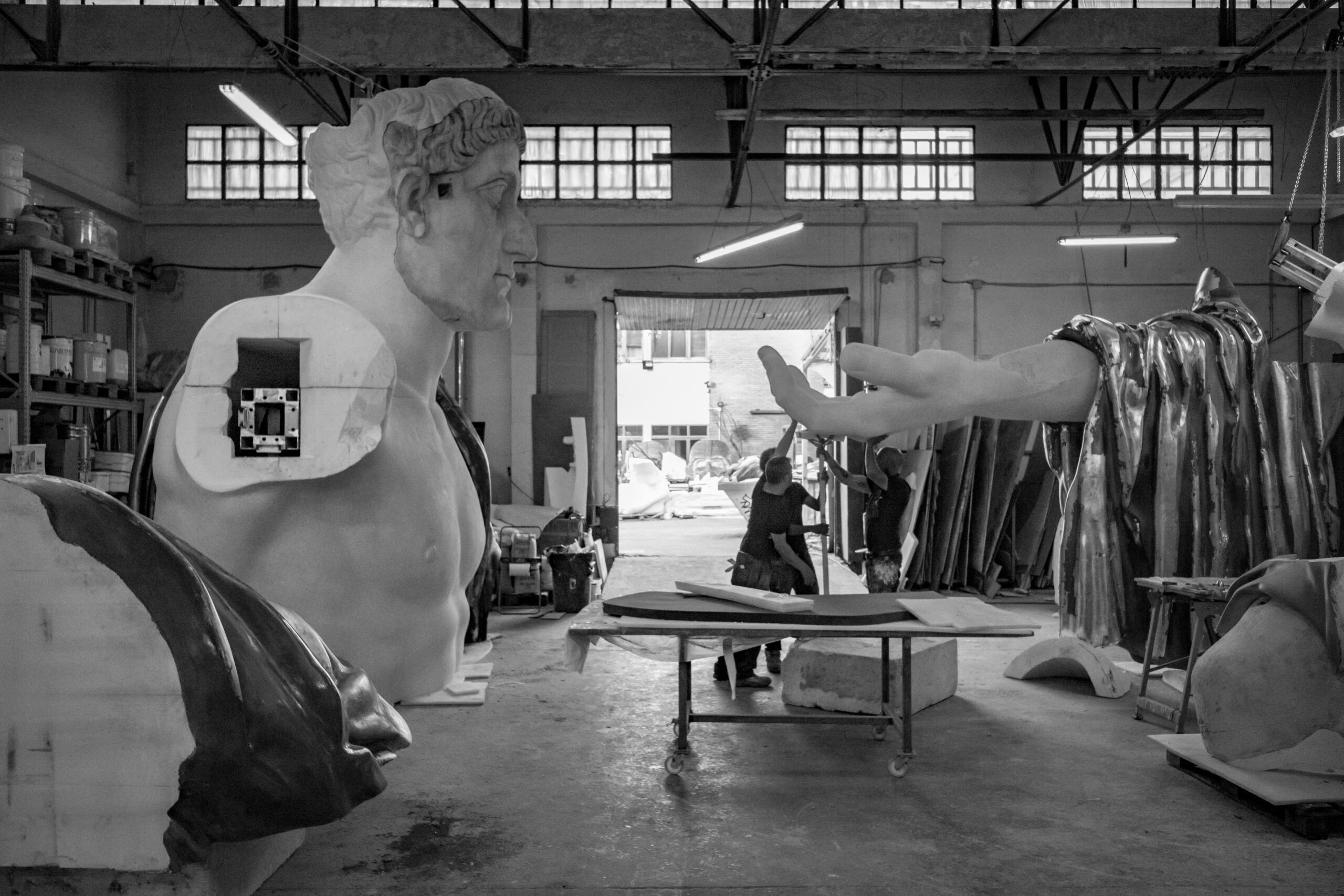At the Capitoline Museums, in the garden of Villa Caffarelli, the imposing full-scale reconstruction of the Colossus of Constantine
The statue, around 13 metres tall, was rebuilt from original fragments preserved in the Capitoline Museums dating from the 4th century A.D. using innovative reconstruction techniques.
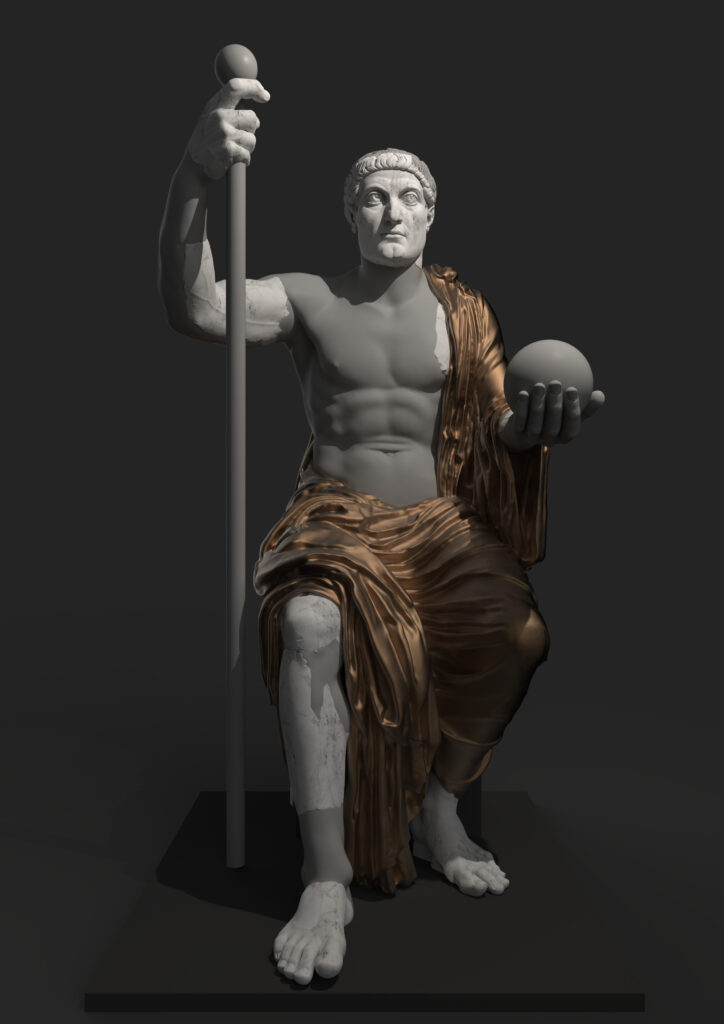
Rome, 6 February 2024 – Among the most important works of antiquity, with its height of around 13 metres, the colossal statue of Constantine (4th century AD), was one of the most significant examples of late antique Roman sculpture. Of the entire statue, rediscovered in the 15th century in the Basilica of Maxentius, only a few monumental marble fragments remain today, housed in the courtyard of Palazzo dei Conservatori at the Capitoline Museums: the head, right arm, wrist, right hand, right knee, right shin, right foot, left foot.
From today on, we may admire in all its grandeur, in the garden of Villa Caffarelli, the extraordinary 1:1 scale reconstruction of the Colossus, result of the collaboration between the Capitoline Superintendence, the Prada Foundation and the Factum Foundation for Digital Technology in Preservation, with the scientific supervision of Claudio Parisi Presicce, Capitoline Superintendent of Cultural Heritage.
The replica of the monument has been presented today to the audience by the Mayor of Roma Capitale, Roberto Gualtieri, by the Councilor for Culture of Roma Capitale, Miguel Gotor, by the Superintendent Claudio Parisi Presicce, by the member of the Prada Foundation Steering Committee, Salvatore Settis, and by Adam Lowe, of the Factum Foundation for Digital Technology in Preservation.
The project is promoted by Roma Capitale, the Department of Culture, Capitoline Superintendence of Cultural Heritage and carried out with the contribution/funding of the Prada Foundation – which hosted the first exhibition of the work in Milan from 17 November 2022 to 27 February 2023, to mark the Recycling Beauty exhibition curated by Salvatore Settis with Anna Anguissola and Denise La Monica. “Recycling Beauty,” designed by Rem Koolhaas/OMA, was an unprecedented study dedicated entirely to the reuse of Greek and Roman antiquities in post-antique contexts, from the Middle Ages to the Baroque era.
The Garden of Villa Caffarelli, where the reproduction of the Colossus of Constantine has been placed, is situated in part upon the area occupied by the Temple of Jupiter Optimus Maximus, which once housed the statue of Jupiter, the same one perhaps from which the Colossus was obtained or which, in any case, inspired it. The remains of the temple can be seen today inside the Exedra of Marcus Aurelius.
The reconstruction project of the colossal statue of Constantine stemmed from significant research involving the archaeological, historical and functional analysis of the fragments, supported by the evaluation of literary and epigraphic sources.
The nine fragments in Parian marble, currently preserved in the Capitoline Museums, were found in 1486 inside the apse of a building that at the time was believed to be Vespasian’s Temple of Peace, and which only at the beginning of the 19th century was to be correctly identified as the Basilica of Maxentius along the Via Sacra. They were thought to belong to a statue of Emperor Commodus and, given their exceptional significance, were set up in the Palazzo dei Conservatori during the renovation of the same, undertaken according to Michelangelo’s plan between 1567 and 1569.
The fragments were only to be identified as a colossal portrait of Emperor Constantine at the end of the 19th century.
A tenth fragment, part of the torso, found in 1951, is in the process of being transferred from the Colosseum Archaeological Park to the courtyard of the Palazzo dei Conservatori, next to the other fragments.
The archaeological study of the fragments has led to hypothesize that the Colossus was seated and that it was made as an acrolith, i.e. with the bare parts in white marble and the drapery in metal or gilded stucco. According to an iconographic scheme typical of the time, which assimilated the emperor to the divinity, Constantine is represented as Jupiter with the upper part of the body uncovered and the cloak resting on the shoulder; the right arm holding the long-shaft sceptre and the left hand holding the globe.
At the end of March 2022, a team from the Factum Foundation spent three days in the courtyard of the Capitoline Museums in order to scan the fragments with the photogrammetry technique.
Each fragment was modelled in 3D and placed on the digital body of the statue created using other cult statues from the imperial age in similar poses as models, including the colossal statue of Jupiter (1st century AD) preserved at the State Hermitage Museum in St. Petersburg, probably inspired by the Zeus of Olympia by Phidias and the large plaster copy of the statue of Emperor Claudius, portrayed as Jupiter, on display at the Ara Pacis Museum.
The complex reconstruction operations carried out by Factum took multiple factors into account: the type of marble of the original parts, the restorations and additions; the details of the missing drapery and the appearance of the gilded bronze of which it was composed; the relationship between the reconstruction and the surviving fragments, the condition of these and their exact location. After completing the very high resolution 3D model, they then proceeded with the material reconstruction of the Colossus in the Madrid workshop.
Resin and polyurethane, together with marble powder, gold leaf and plaster, were the chosen materials to make the surfaces of marble and bronze, while for the internal structure (originally perhaps composed of bricks, wood and metal bars) an easily assembled and removable aluminium support was used.
The final result, as if a magnificent illusion, allows you to admire the Colossus as a whole, in which the “stitching together” of the rematerialized parts and the copies of the original fragments present in the Courtyard of Palazzo dei Conservatori can be visually distinguished.
Information
Entrance
Piazzale Caffarelli, 2
Visiting times
Daily from 9.30 AM to 7.30 PM
Entrance fee
Free
For further information:
060608 (every day between 9 AM-7 PM) – www.museicapitolini.org
The Colossus of Constantine
Since the end of the 15th century, the courtyard of the Palazzo dei Conservatori has housed nine Parian marble fragments of one of ancient Rome’s most impressive statues, the Colossus of Constantine (306-337 AD), the emperor who is credited with initiatives that would profoundly alter the Roman empire: the official recognition of the Christian religion (313 AD) and the transfer of the capital from Rome to Constantinople (326 AD).
The portrait remained without a certain identity until the late 19th century, when it was correctly identified as Emperor Constantine. Subsequent studies made it possible to recognize sure signs of rework, especially at the chin and chin strap, indicating that the person originally depicted had a beard.
The Colossus is thus the result of the reworking of an older statue. According to a recent working hypothesis, it could be the cult statue of Jupiter Optimus Maximus, placed inside the temple dedicated to him on the Capitoline Hill, the most important in Roman times. At any rate, this statue, known from several replicas or imitations, must have been the model for the creation of the Colossus of Constantine. One of its most faithful reproductions, in reduced size, dating to the Flavian period (69-96 AD), is the one preserved today in the Hermitage in St. Petersburg. The statue is an acrolith, with the naked parts made of marble, mounted on a supporting structure covered with draperies of gilded bronze or precious colored marble. The god, seated on a throne, is wrapped in a cloak that leaves his torso, arms, and knee uncovered. The latter is an iconographic motif of the Homeric tradition associated almost exclusively with the image of Jupiter and later of the emperors, which is inspired by it as a sign of the devotion paid to them by their subjects. With his bare knee, Jupiter is shown on coins and medallions from the immediately pre-Constantinian era, with dedication to Iuppiter Conservator.
In 312 AD, after his victory over Maxentius at the Milvian Bridge, Constantine became the absolute master of the western part of the empire and of Rome. To these first years of his reign would date the making of the Colossus, which, in its hieratic fixity, constitutes one of the most impressive manifestations of Constantinian art. The celebration of the emperor thus takes place through the reuse of an existing colossal statue depicting an emperor or deity, such as Jupiter Optimus Maximus. Through it Constantine shows himself as comes (companion) of the gods and the very nature of his power is manifested as divine.
The history of the fragments
The exceptional nature of the find prompted the acquisition of the fragments to the courtyard of the Palace, at the time the seat of the Conservatori, the most important Capitoline magistracy, which already housed the precious nucleus of ancient bronzes, including the famous She-wolf and fragments of the bronze Colossus of Constantine, donated to the Roman People by Pope Sixtus IV in 1471.
The event is commemorated by an important inscription walled in the courtyard of the Palazzo dei Conservatori, surmounted by the coats of arms of the Roman senate, Pope Innocent VIII (reg. 1484 – 1492) and Cardinal Raffaele Riario.
Drawings and prints made since the first half of the 16th century provide valuable evidence of the way in which, over the centuries, the arrangement of the fragments, which soon became the very symbol of Rome’s lost and recovered majesty, has changed.
The display of the Colossus at Villa Caffarelli
The Villa Caffarelli Garden, where the life-sized integral reproduction of the Colossus of Constantine is set up today, insists in part on the area occupied by the Temple of Jupiter Optimus Maximus, which once housed the statue of Jupiter, the same one from which perhaps the Colossus was derived or at any rate the one that was its model. The remains of the temple are visible today inside the Exedra of Marcus Aurelius.
The temple was dedicated in 509 BC by the first consul of the Republic, M. Horatius Pulvillus to the Capitoline triad: Jupiter, Juno, Minerva. The first cult statue of Jupiter was made of terracotta and was the work of the sculptor Vulca of Veio, which in 69 BC, on the occasion of the reconstruction promoted by Sulla, was substituted by a new statue inspired by the famous Zeus of Olympia by Phidias: seated on a throne, the torso uncovered, a cloak covering the legs.
After the severe fire of 80 AD, during the reign of Emperor Titus, a further makeover was undertaken, concluded by Domitian, his brother and successor. Again, the cult statues of Jupiter, Juno, and Minerva were replaced. For Jupiter the model is still the statue of Phidias, reproduced as an acrolith in marble. Little is now preserved of Domitian’s temple, but the sumptuous decoration of the pediment is documented by a famous historical relief now in the Capitoline Museums, from an honorary monument of Marcus Aurelius and depicting the sacrifice at the temple of Capitoline Jupiter.
Between 217 and 222 AD, a lightning bolt severely damaged the statue of Jupiter. This event may have set the stage for its reuse to celebrate the new emperor Constantine in the early fourth century AD. Whatever statue was reworked to make the Colossus, Constantine nonetheless appropriated one of the symbols of the Roman religion to legitimize his rise to power, placing it in a location of great value: the basilica of Maxentius along the Via Sacra, the last public architectural monument of a civil character that was built in ancient Rome.
The reconstruction process
The project to reconstruct the colossal figure of Constantine started, under the initiative of the Sovrintendenza Capitolina, from an agreement between Fondazione Prada, which financed the operation, Factum Foundation for Digital Technology in Preservation, a leading company in the field of digitization of works of art, and the Sovrintendenza itself, on the occasion of the exhibition Recycling Beauty, where the Colossus has already been exhibited between 2022 and 2023, to then find its natural location in the Villa Caffarelli Garden, in the area next to that of the Temple of Capitoline Jupiter.
The project was carried out by Factum Foundation from the ten known fragments of the sculpture, starting from this archaeological hypothesis: the Colossus was seated and must have been made as an acrolith, that is, with the bare parts in white marble and the drapery in gilded bronze.
Factum Foundation used photogrammetry to document the fragments of the Colossus preserved in the courtyard of the Palazzo dei Conservatori and the fragment of the chest preserved at Parco Archeologico del Colosseo, which, thanks to an agreement with the Ministry of Culture, will be reunited with the other fragments preserved in the Courtyard. Photogrammetry of the cast of the statue of Emperor Claudius as Jupiter, now in the Ara Pacis, was used as a model for the pose and draping. Numerous details were reconstructed from reading literary and epigraphic sources and comparing with other seated statues from the imperial period.
The digital data was rematerialised as 1:1 3D prints, which were used to make positive casts in reinforced resin. For the facsimile fragments, the surface was coated with a custom gesso mix and painted to resemble the original marble, weathered by the exposure to the elements. The recreated sections were made in polyurethane, coated in several layers of resin mixed with marble powder and mica, to achieve a clean neutral marble-white colour. The cloak and the gilded bronze elements was made in milled polystyrene, coated with acrylic resin mixed with bronze powder, over which a gold foil gilding was applied.
The original Colossus, which was about 13 meters tall, had an internal structure hypothetically made of brick, wood, and metal elements. For the reconstruction, Factum Foundation used an aluminum support structure, which allows for its assembly and disassembly.
Press release from Zètema Progetto Cultura

